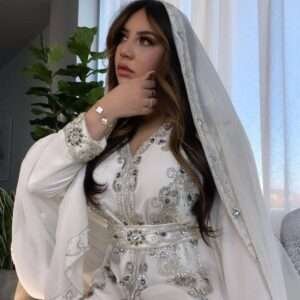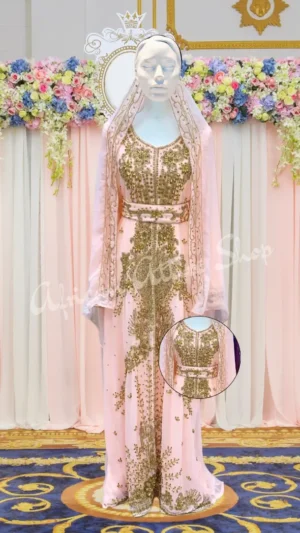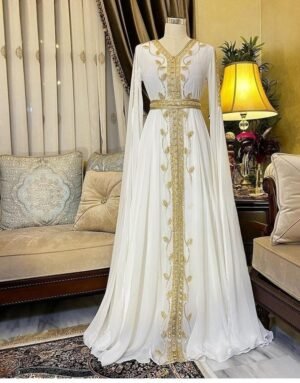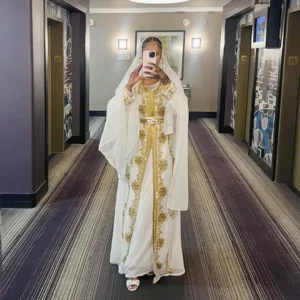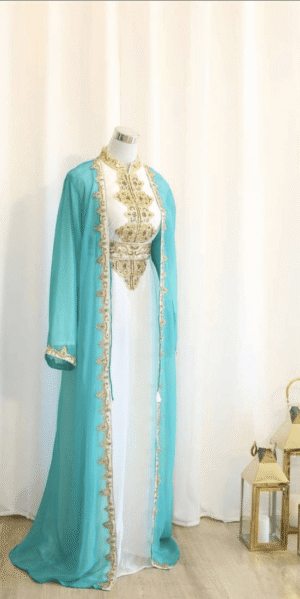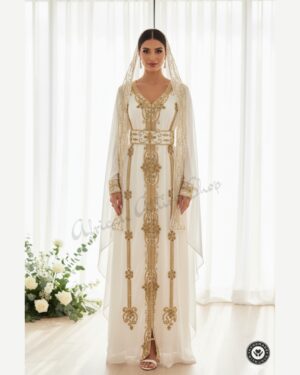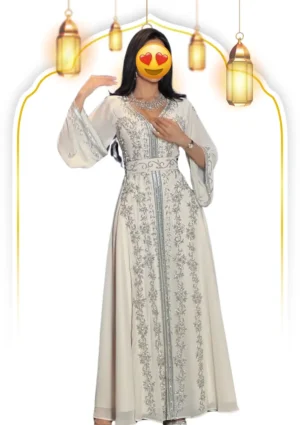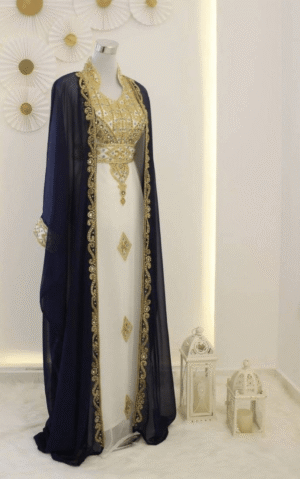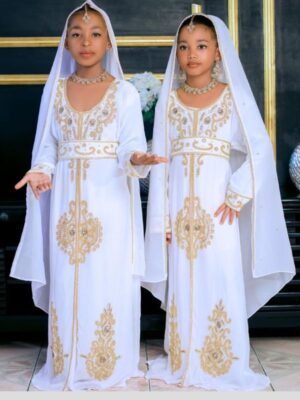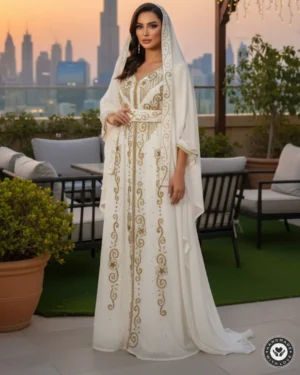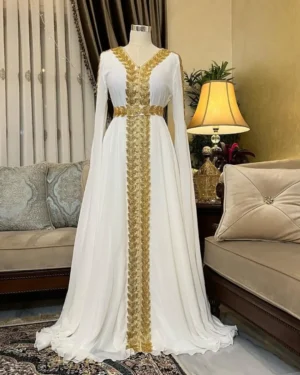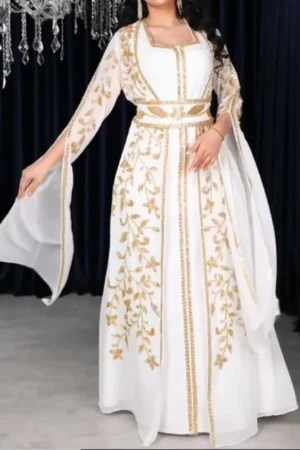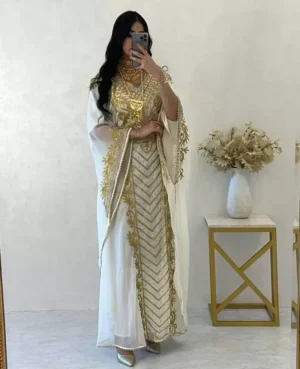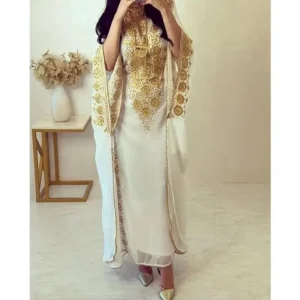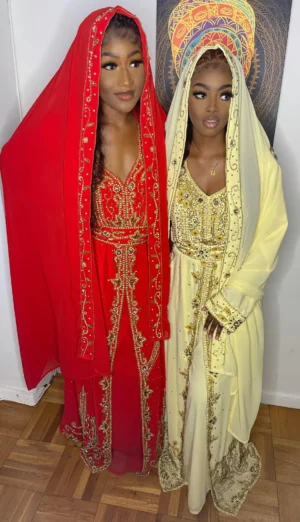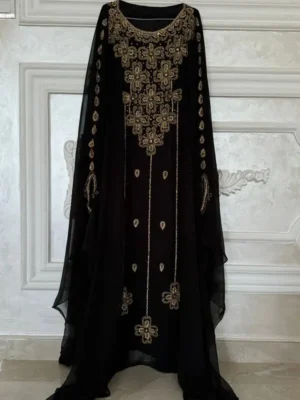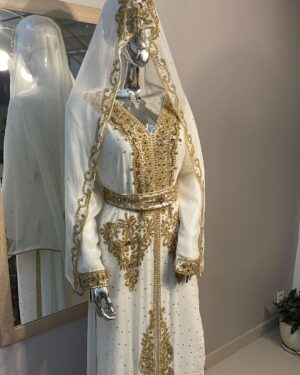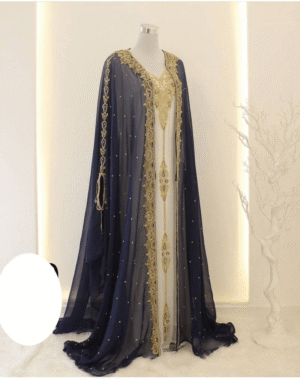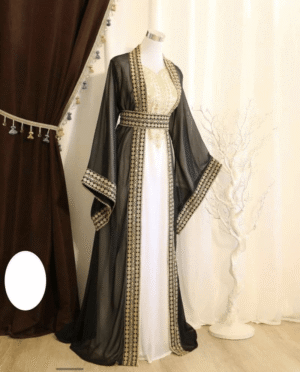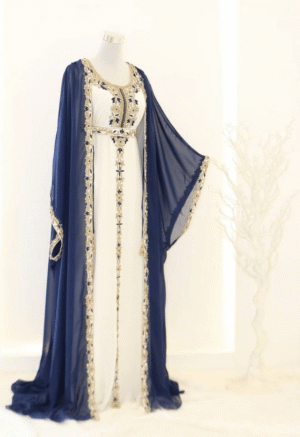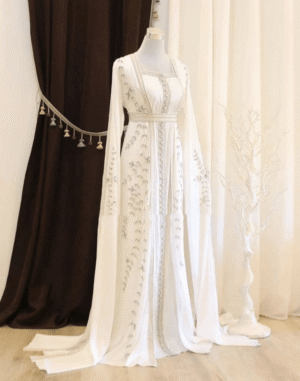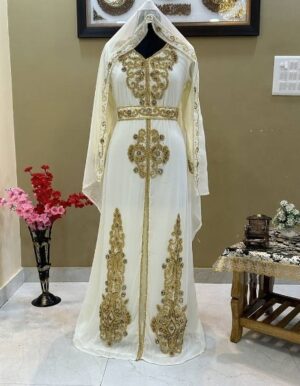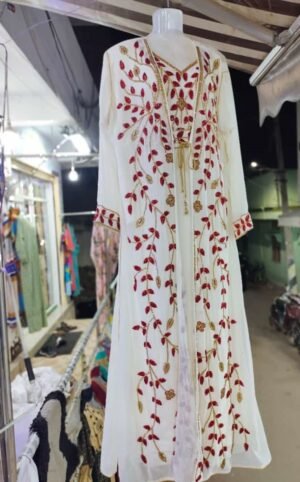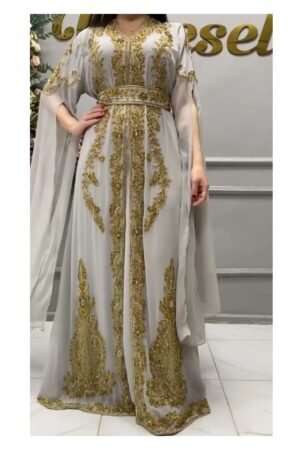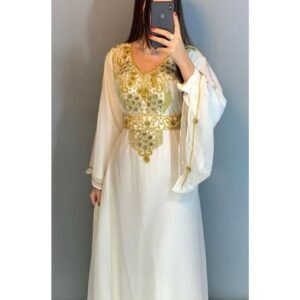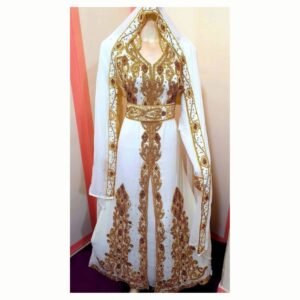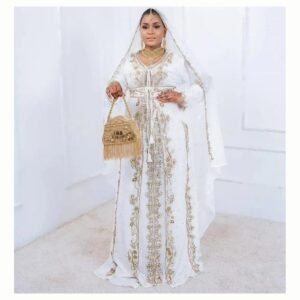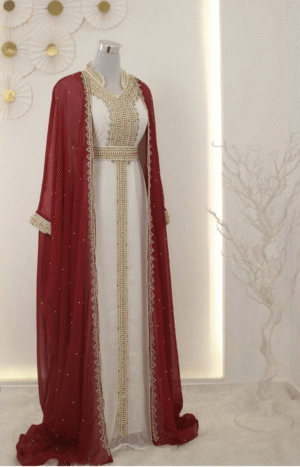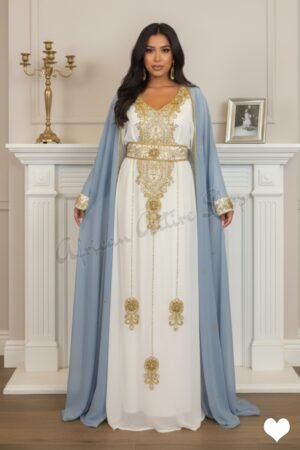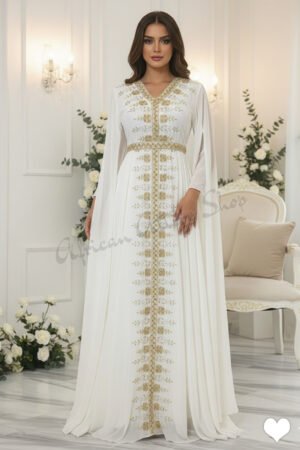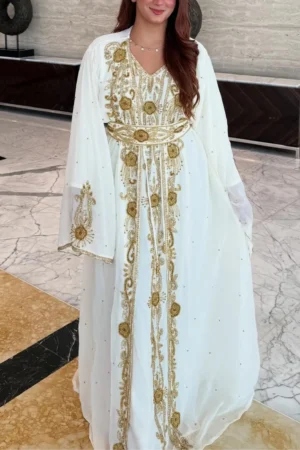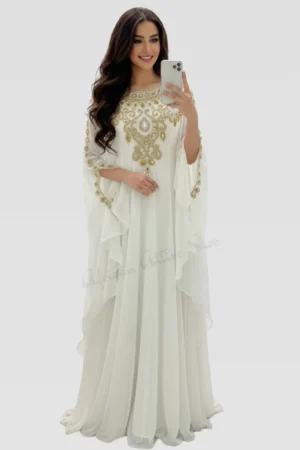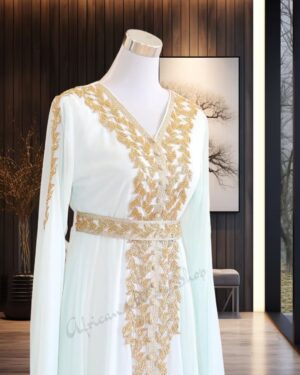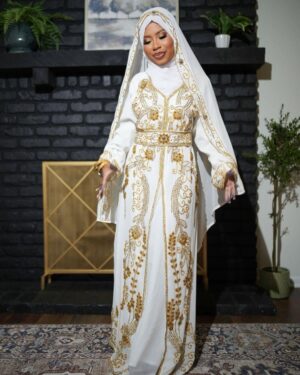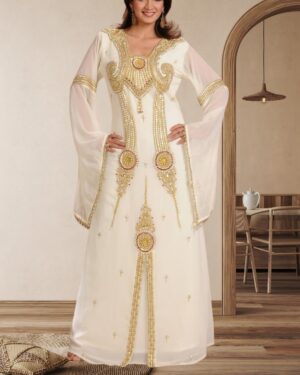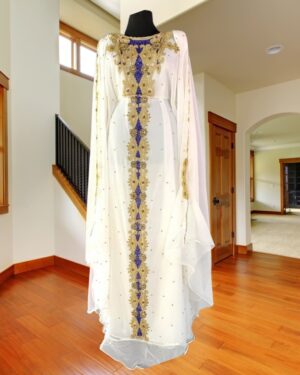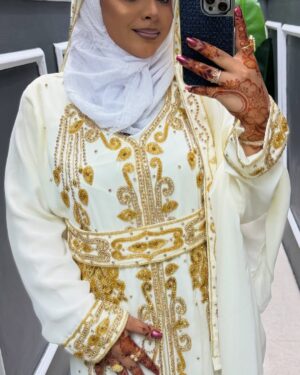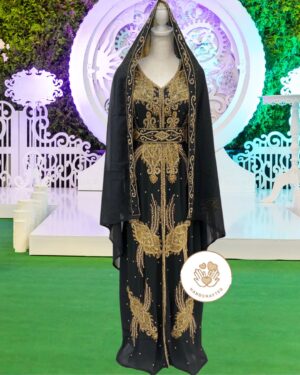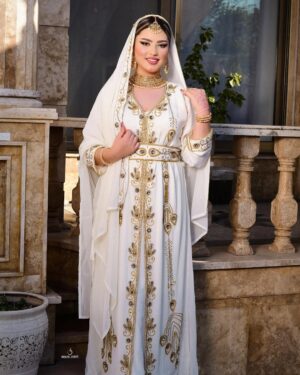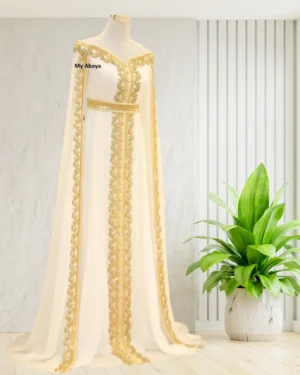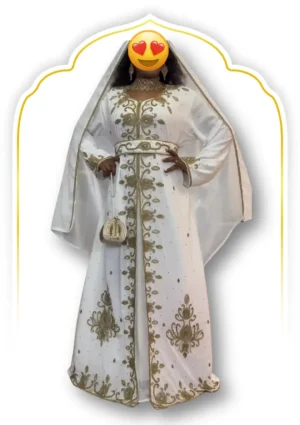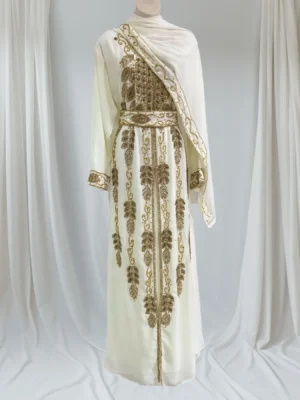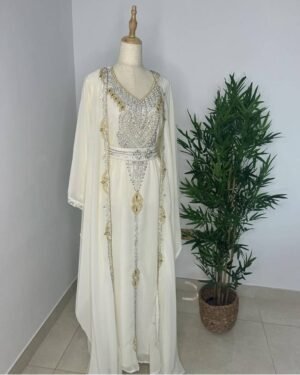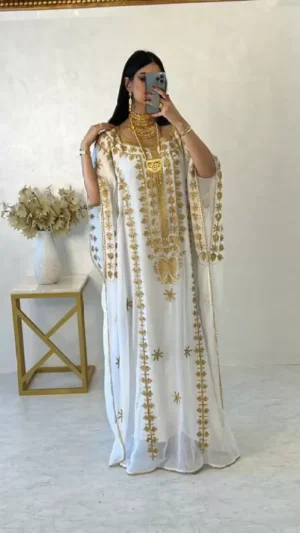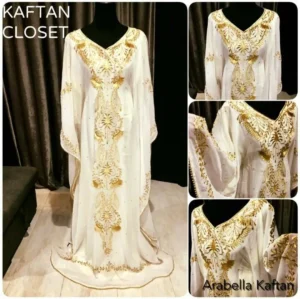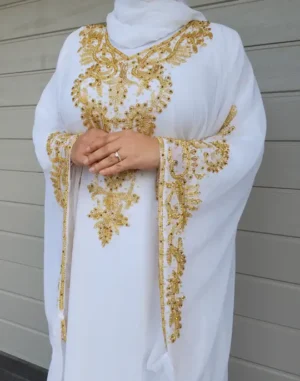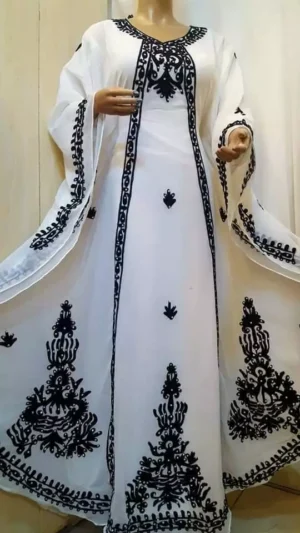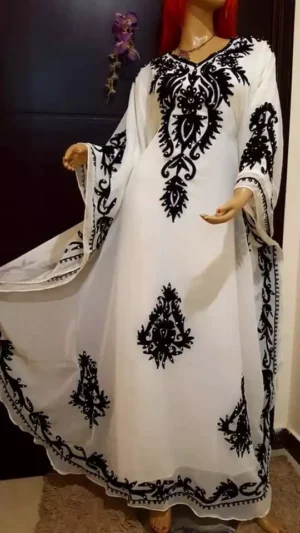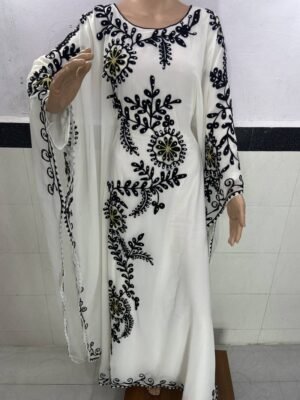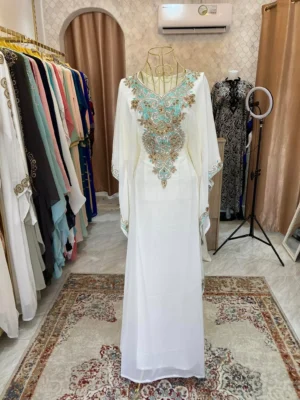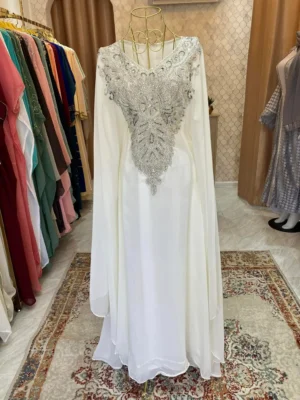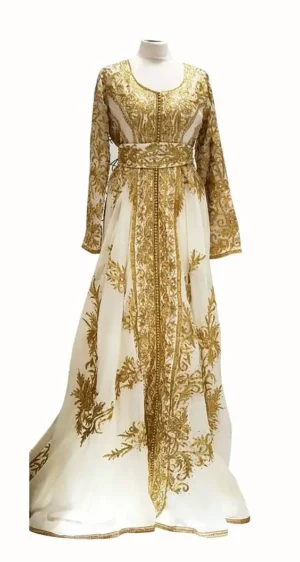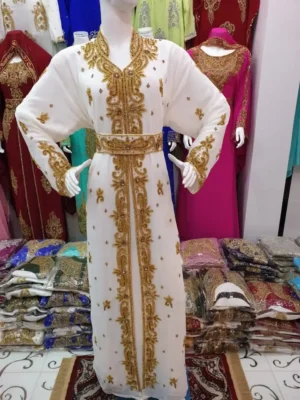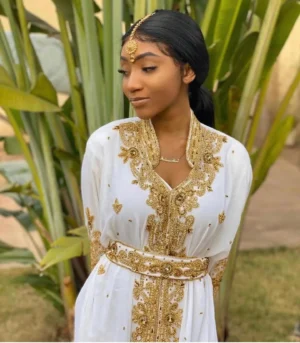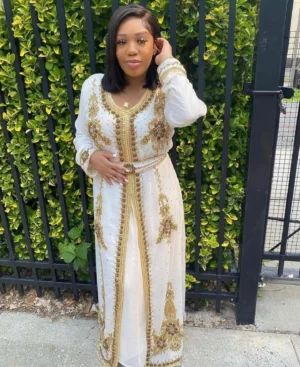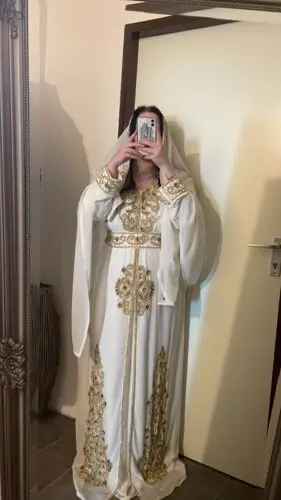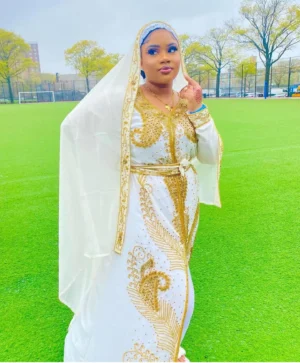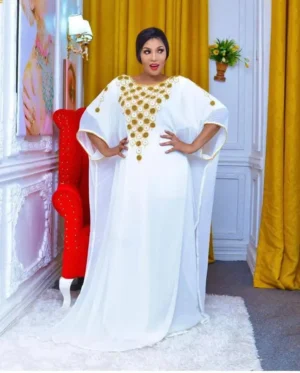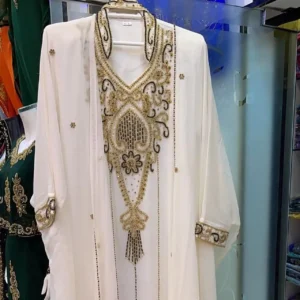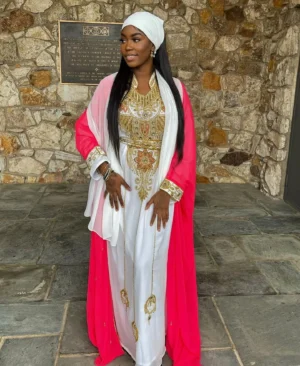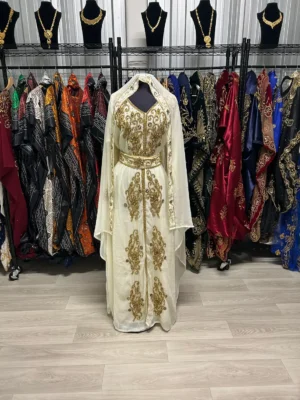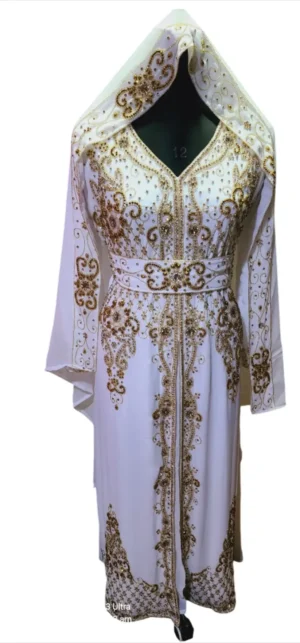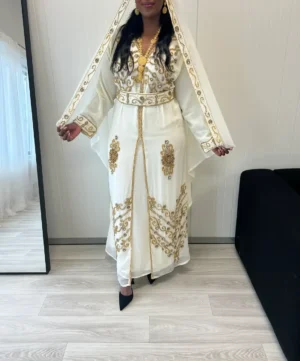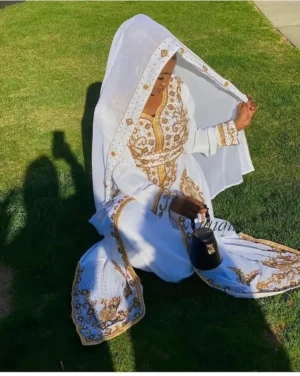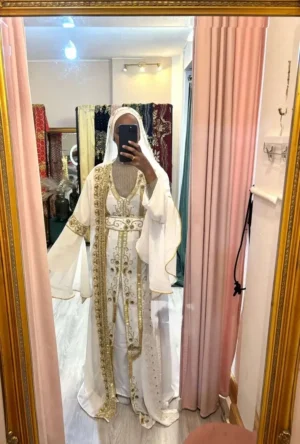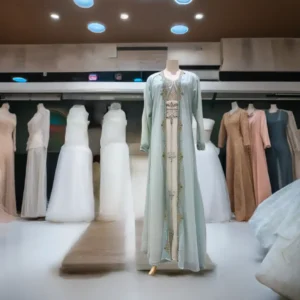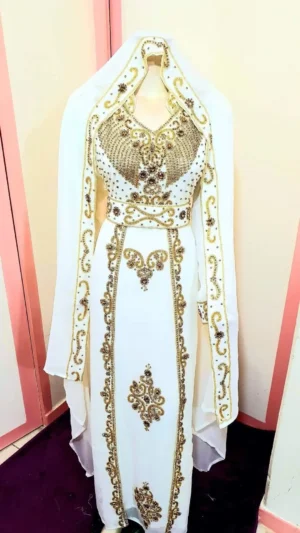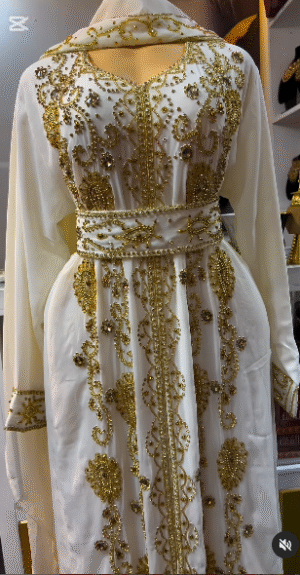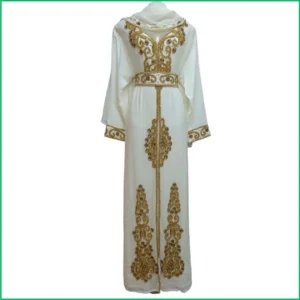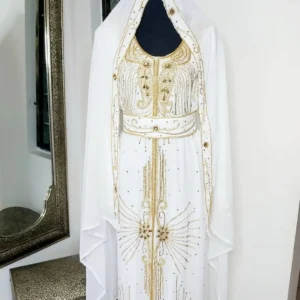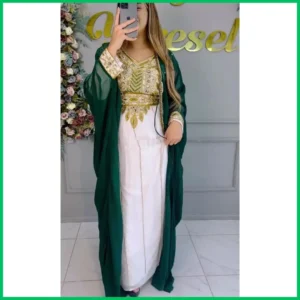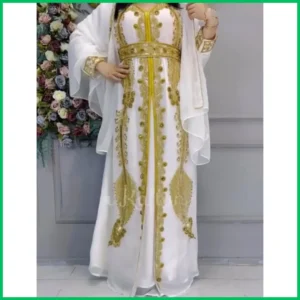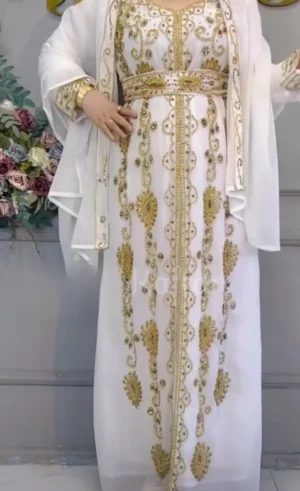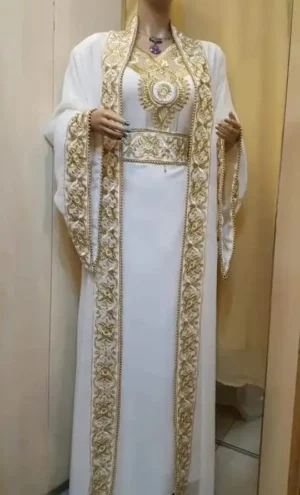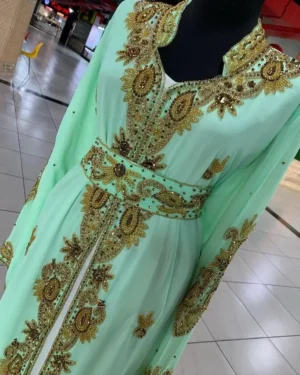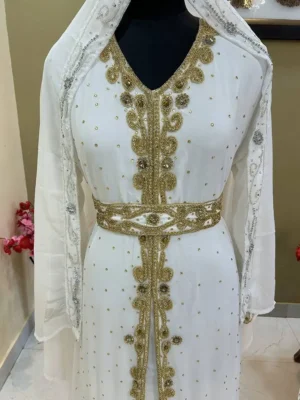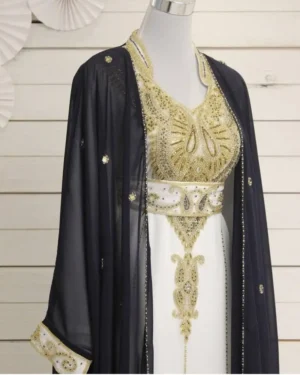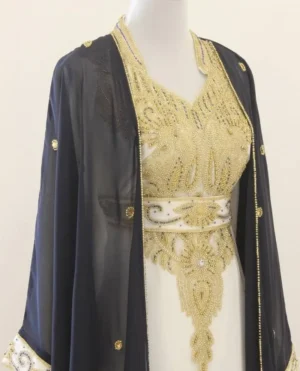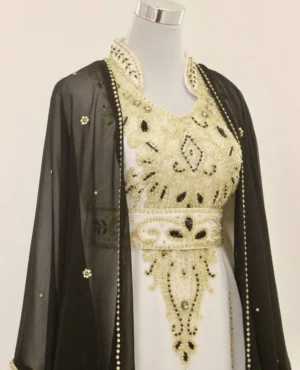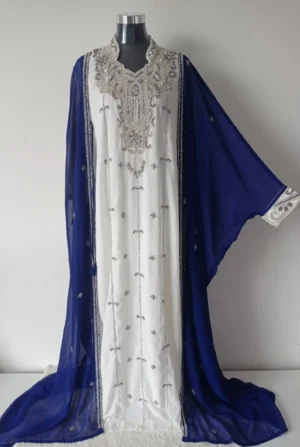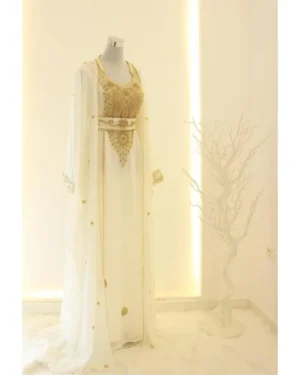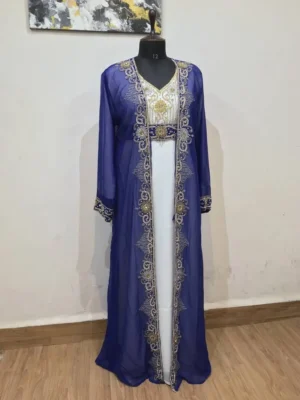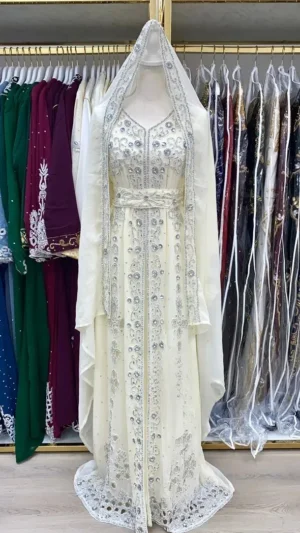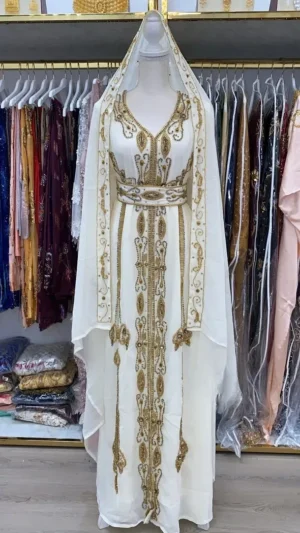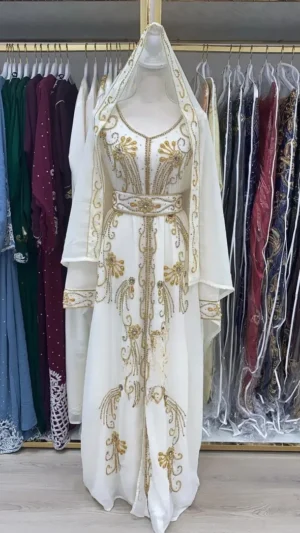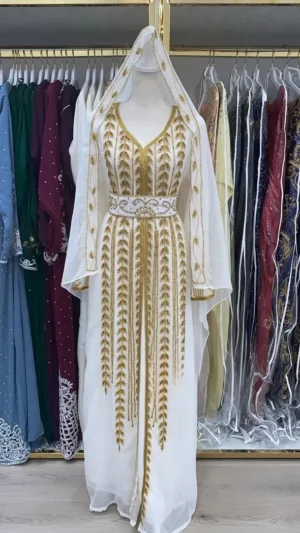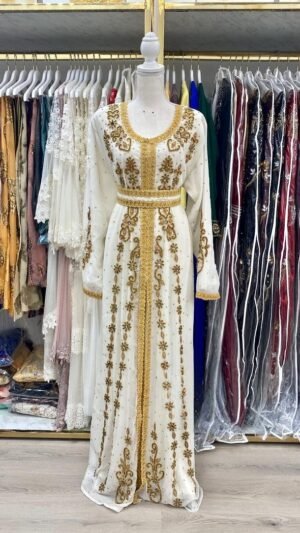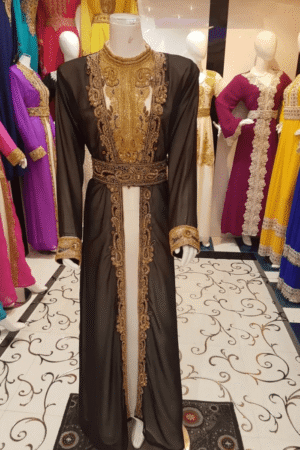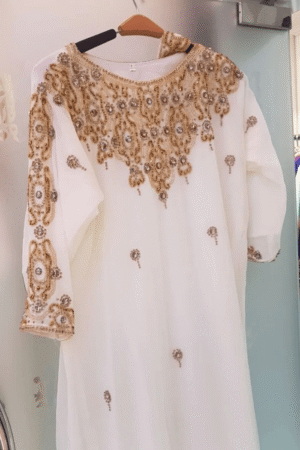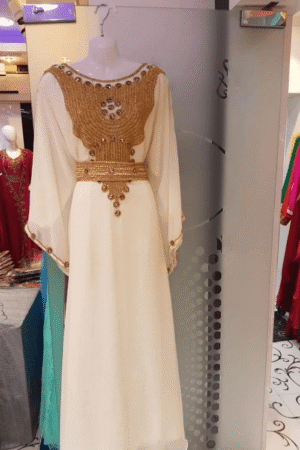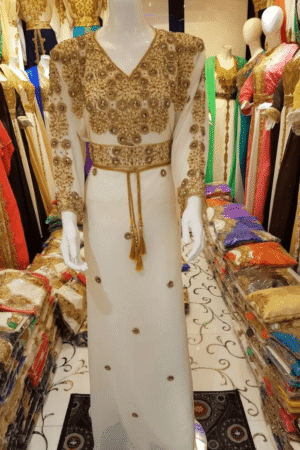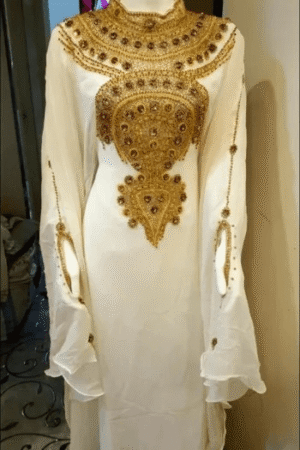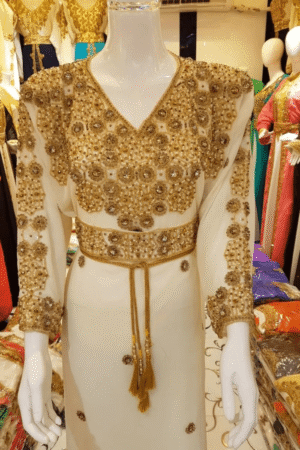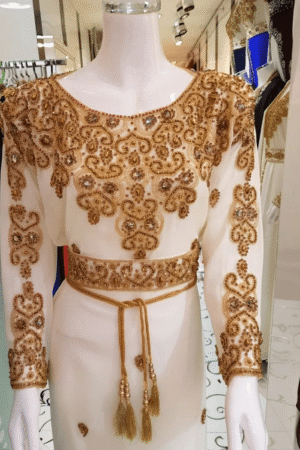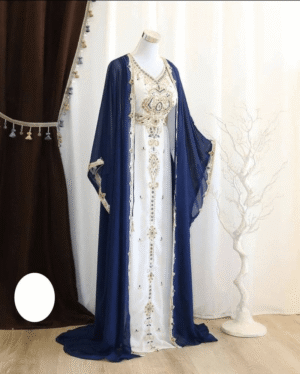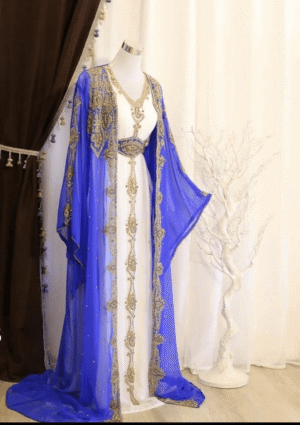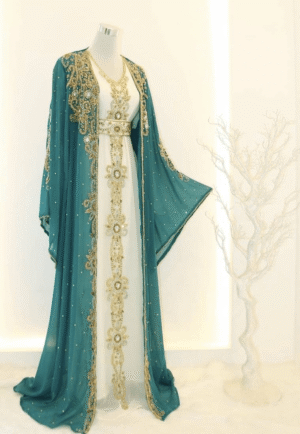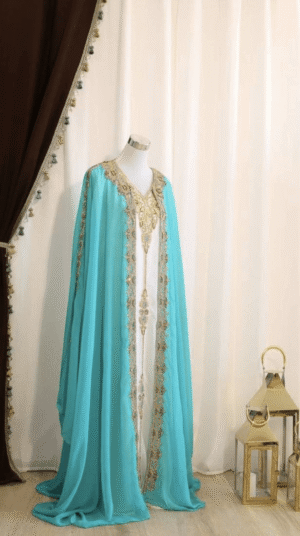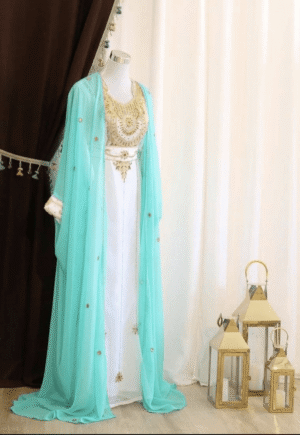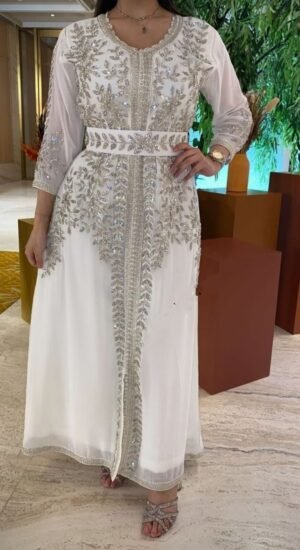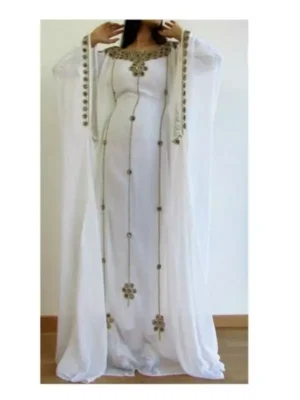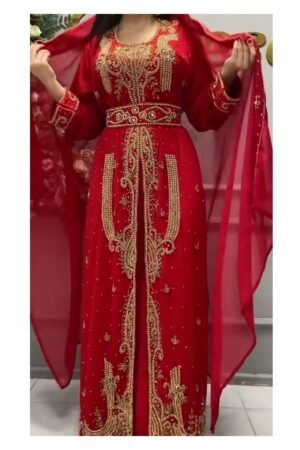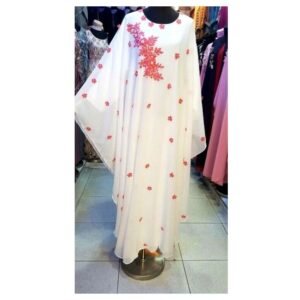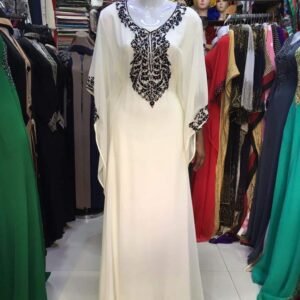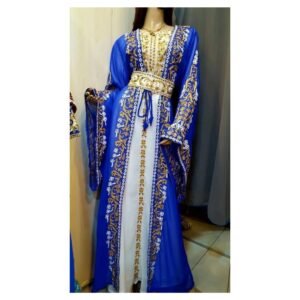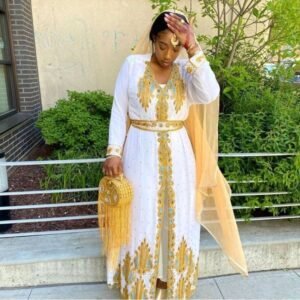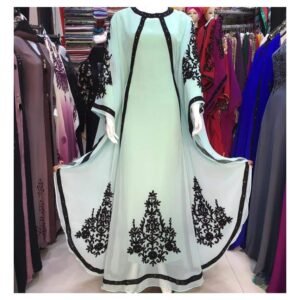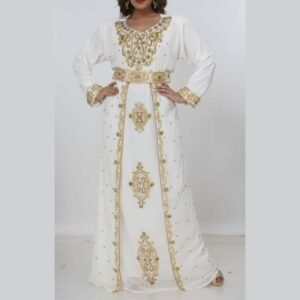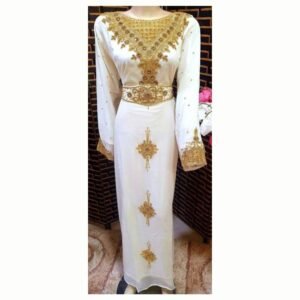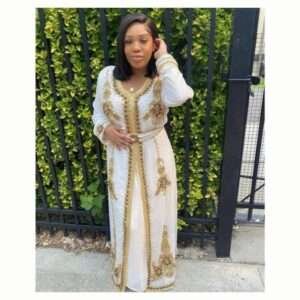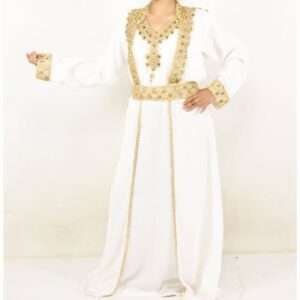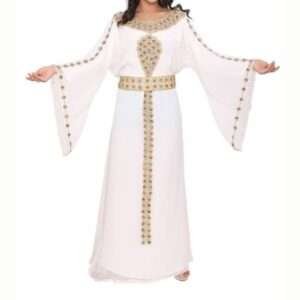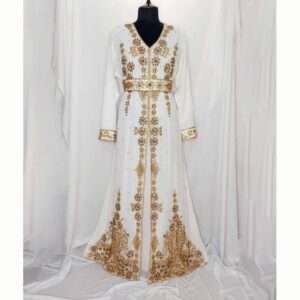-
Dubai Kaftan Moroccan Dress Fancy Long Gown
Rated 5.00 out of 5$140.00Original price was: $140.00.$84.00Current price is: $84.00. -
SALE! White & Gold Embroidered Moroccan Kaftan – Luxury Handmade Bridal & Evening Gown – Limited Stock!
Rated 5.00 out of 5$158.00Original price was: $158.00.$94.00Current price is: $94.00. -
Royal White Wedding Islamic Kaftan – Elegant Dubai Moroccan Caftan for Nikkah, Parties, and Special Occasions
Rated 5.00 out of 5$197.00Original price was: $197.00.$118.00Current price is: $118.00. -
Elegant Moroccan White Dubai Kaftan Abaya Dress – Modern Farasha Gown for Weddings, Eid, and Special Occasions
Rated 5.00 out of 5$133.00Original price was: $133.00.$80.00Current price is: $80.00. -
Royal Moroccan Wedding Kaftan Gold Hand-Embroidered Nikkah Abaya Dress | Maxi Floor Length Muslim Wedding/Eid/Ramadan/Party with Hijab
Rated 5.00 out of 5$200.00Original price was: $200.00.$120.00Current price is: $120.00. -
Stunning White African Caftan Handcrafted Maxi Dress for Women (Moroccan, Dubai Kaftan Inspired)
Rated 5.00 out of 5$148.00Original price was: $148.00.$89.00Current price is: $89.00. -
White & Gold Embroidered Abaya – Luxury Hand-Beaded Dubai Kaftan Dress | Modest Wedding, Eid & Evening Wear
Rated 4.00 out of 5$140.00 -
White Dubai Kaftan Dress with Gold Hand Embroidery | Luxury Moroccan Bridal & Eid Gown
Rated 5.00 out of 5$180.00Original price was: $180.00.$108.00Current price is: $108.00. -
White Moroccan Kaftan with Exquisite Gold Hand Embroidery: Ideal for Eid, Weddings, and Gifting
Rated 5.00 out of 5$145.00Original price was: $145.00.$87.00Current price is: $87.00. -
Navy Blue and White Zari Kaftan Wedding Dress | Handcrafted Georgette Party Gown
Rated 5.00 out of 5$148.00Original price was: $148.00.$89.00Current price is: $89.00. -
Sky Blue & White Handcrafted Zari Work Stitched Georgette Kaftan for Party and Wedding
Rated 5.00 out of 5$148.00Original price was: $148.00.$89.00Current price is: $89.00. -
Beautiful White Kaftan Moroccan Dress African party wear Long Gown
Rated 5.00 out of 5$130.00Original price was: $130.00.$78.00Current price is: $78.00. -
White & Gold Moroccan Bridal Kaftan – Dubai Luxury Hand-Embroidered Nikkah Dress – Limited Stock!
Rated 5.00 out of 5$180.00Original price was: $180.00.$108.00Current price is: $108.00. -
SALE White Moroccan Kaftan Dress with Gold Hand Embroidery – Bridal Nikkah & Event
Rated 5.00 out of 5$145.00Original price was: $145.00.$87.00Current price is: $87.00. -
SALE Elegant White and Gold Moroccan Kaftan Dress for Women
Rated 5.00 out of 5$167.00Original price was: $167.00.$100.00Current price is: $100.00. -
Luxury White & Gold Hand-Beaded Moroccan Kaftan | Farasha Style Bridal Gown
Rated 4.00 out of 5$140.00Original price was: $140.00.$84.00Current price is: $84.00. -
White Embroidered Kaftan Handcrafted Plunging V-Neck Dress for Weddings & Special Events
$140.00Original price was: $140.00.$84.00Current price is: $84.00. -
White Aari Embroidered Kaftan Dress Elegant Embroidery Kaftan for Weddings and Formal Events
$140.00Original price was: $140.00.$84.00Current price is: $84.00. -
Navy Blue and White Zari Embroidered Georgette Kaftan Dress for Wedding or Party
$148.00Original price was: $148.00.$89.00Current price is: $89.00. -
White Baby Kaftan Dress | Adorable & Elegant for Any Occasion (Size: 2-16 Years)
$137.00Original price was: $137.00.$82.00Current price is: $82.00. -
New Moroccan Dubai Kaftan Farasha Abaya Wedding Dress
Rated 5.00 out of 5$130.00Original price was: $130.00.$78.00Current price is: $78.00. -
Navy Blue and White Handcrafted Zari Kaftan Dress | Georgette Wedding Guest Dress | Party Wear
Rated 5.00 out of 5$133.00Original price was: $133.00.$80.00Current price is: $80.00. -
White Moroccan Bridal Kaftan with Gold Embroidery – Luxury Nikkah & Wedding Dress
Rated 5.00 out of 5$192.00Original price was: $192.00.$115.00Current price is: $115.00. -
SALE Stunning White Moroccan Kaftan Dress with Gold Hand Embroidery
$170.00Original price was: $170.00.$102.00Current price is: $102.00. -
SALE White & Silver Embroidered Moroccan Bridal Kaftan – Elegant Nikah & Engagement Dress with Belt
$167.00Original price was: $167.00.$100.00Current price is: $100.00. -
Royal White & Gold Hand-Embroidered Nikkah Abaya – Bridal Kaftan Gown with Hooded Cape
Rated 5.00 out of 5$175.00Original price was: $175.00.$105.00Current price is: $105.00. -
White and Gold Embroidered Farasha Abaya Handmade Dubai Kaftan for Party, Wedding, and Special Occasions
Rated 5.00 out of 5$200.00Original price was: $200.00.$120.00Current price is: $120.00. -
White Moroccan Kaftan with Luxurious Gold Aari Embroidery
$120.00Original price was: $120.00.$75.00Current price is: $75.00. -
White Premium Luxury Gold Aari Work on Dubai Farasha Abaya Kaftan
$120.00Original price was: $120.00.$72.00Current price is: $72.00. -
SALE! Handcrafted Moroccan Kaftan Abaya Farasha Fancy Gown
$130.00Original price was: $130.00.$78.00Current price is: $78.00. -
SALE! Dubai Style Fancy Farasha Abaya Dress with Embroidery – Perfect for Weddings
$130.00Original price was: $130.00.$78.00Current price is: $78.00. -
White Luxury Kaftan Dress | Perfect for Special Occasions Traditional Kaftan | Handmade with Love
$132.00Original price was: $132.00.$79.00Current price is: $79.00. -
Royal White Kaftan Wedding/Nikah Islamic Dress Modern Fancy Elegant Dubai Moroccan Caftan
Rated 5.00 out of 5$132.00Original price was: $132.00.$79.00Current price is: $79.00. -
Elegant Green Eid Kaftan Dress Moroccan Style with Intricate Zari Embroidery
$132.00Original price was: $132.00.$79.00Current price is: $79.00. -
Stylish Luxuries Grey & White Inner Jacket Kaftan Embroidered Zari Work Wedding Dress
$258.00Original price was: $258.00.$155.00Current price is: $155.00. -
Sale!! White Bridal Dubai Kaftan Abaya | Nikkah Handmade Women Gown
$138.00Original price was: $138.00.$83.00Current price is: $83.00. -
Classic White Kaftan Abaya Timeless and Elegant
$140.00Original price was: $140.00.$84.00Current price is: $84.00. -
Navy Blue and White Zari Kaftan Dress | Handcrafted Georgette Wedding Guest Dress
$148.00Original price was: $148.00.$89.00Current price is: $89.00. -
Navy Blue & White Handcrafted Zari Work Stitched Dress Georgette Kaftan Party Wear Wedding Dresses
Rated 5.00 out of 5$140.00Original price was: $140.00.$84.00Current price is: $84.00. -
Black and White Zari Kaftan Dress Handcrafted Georgette for Weddings & Parties
$148.00Original price was: $148.00.$89.00Current price is: $89.00. -
Navy Blue and White Zari Embroidered Georgette Kaftan Dress for Wedding & Party
$148.00Original price was: $148.00.$89.00Current price is: $89.00. -
Elegant White Handcrafted Zari Work Stitched Georgette Kaftan for Party and Wedding
$148.00Original price was: $148.00.$89.00Current price is: $89.00. -
Beautiful Off-White Dubai Moroccan Beaded Kaftan – Plus Size Arabian Party Dress with Crystal Work for Weddings and Special Occasions
Rated 5.00 out of 5$140.00Original price was: $140.00.$84.00Current price is: $84.00. -
Sale! Beautiful Flower Dubai Kaftan Dress
$152.00Original price was: $152.00.$91.00Current price is: $91.00. -
Royal Dubai Arabic Moroccan Kaftan Dress White
Rated 5.00 out of 5$140.00Original price was: $140.00.$84.00Current price is: $84.00. -
Dubai White Moroccan Kaftan Arabian Dress
$120.00Original price was: $120.00.$72.00Current price is: $72.00. -
White Dubai Arabian Moroccan Kaftan Abaya Farasha Dress
$130.00Original price was: $130.00.$78.00Current price is: $78.00. -
White Moroccan Kaftan Abaya Farasha Dubai Caftan Gown Maxi Dress
$120.00Original price was: $120.00.$72.00Current price is: $72.00. -
Beautiful Zari Stone Work White Kaftan Dress Long Gown
Rated 5.00 out of 5$140.00Original price was: $140.00.$84.00Current price is: $84.00. -
Beautiful Islamic Hand Beaded Dubai Moroccan Fancy Dress Ladies Floor Length
$140.00Original price was: $140.00.$84.00Current price is: $84.00. -
Exquisite White Moroccan Wedding Dress for Women – African Attire Shop
Rated 5.00 out of 5$130.00Original price was: $130.00.$78.00Current price is: $78.00. -
Elegant Maroon & White Handcrafted Zari Work Stitched Georgette Kaftan Dress for Party and Wedding
$140.00Original price was: $140.00.$84.00Current price is: $84.00. -
White & Gold Moroccan Bridal Kaftan with Veil – Luxury Hand-Embroidered Nikkah Wedding Dress | Dubai Bridal Abaya
$160.00Original price was: $160.00.$96.00Current price is: $96.00. -
White & Gold Moroccan Kaftan with Sky Blue Cape – Luxury Nikkah & Wedding Abaya | Dubai Bridal Evening Caftan
$190.00Original price was: $190.00.$114.00Current price is: $114.00. -
White Gold Moroccan Bridal Kaftan – Beaded Nikkah Abaya Dress | Dubai Caftan for Muslim Wedding & Evening Event
$167.00Original price was: $167.00.$100.00Current price is: $100.00. -
White Nikah Abaya Kaftan with Gold Hand Embroidery – Elegant Bridal Muslim Dress
$200.00Original price was: $200.00.$120.00Current price is: $120.00. -
SALE!! Luxury White Moroccan Kaftan with Heavy Gold Hand Embroidery – Nikkah Abaya for Bride
$175.00Original price was: $175.00.$105.00Current price is: $105.00. -
SALE!! Royal White Moroccan Kaftan Jacket with Heavy Gold Embroidery – Bridal & Special Occasion Dress
$164.00Original price was: $164.00.$98.00Current price is: $98.00. -
SALE! Luxury White and Gold Dubai Kaftan Dress – Hand Embroidered Arabic Wedding & Party Gown
$210.00Original price was: $210.00.$126.00Current price is: $126.00. -
Stunning White Dubai Kaftan Dress with Gold Embroidery – Luxury Georgette Arabic Evening Gown
$150.00Original price was: $150.00.$90.00Current price is: $90.00. -
SALE Stunning Moroccan Kaftan Dresses in Beige, Pink & White – Luxury Gowns with Silver & Gold Hand Embroidery
$150.00Original price was: $150.00.$90.00Current price is: $90.00. -
SALE White Moroccan Kaftan Dress with Gold Hand Embroidery
$167.00Original price was: $167.00.$100.00Current price is: $100.00. -
White and Gold Moroccan Bridal Kaftan with Matching Cape Veil
$150.00Original price was: $150.00.$90.00Current price is: $90.00. -
SALE Elegant Cream and Gold Moroccan Kaftan Dress for Women
$167.00Original price was: $167.00.$100.00Current price is: $100.00. -
SALE White Moroccan Wedding Kaftan Dress with Royal Blue and Gold Hand Embroidery
$167.00Original price was: $167.00.$100.00Current price is: $100.00. -
SALE White & Gold Moroccan Bridal Kaftan Dress – Hand Embroidered Work Wedding Gown
$142.00Original price was: $142.00.$85.00Current price is: $85.00. -
Nikah Moroccan Kaftan Abaya Gown Hand Embellished
$200.00Original price was: $200.00.$120.00Current price is: $120.00. -
White Takchita Moroccan Caftan Dress with Handcrafted Gold Crystal Embroidery – Premium Georgette Bridal Gown
$145.00Original price was: $145.00.$87.00Current price is: $87.00. -
SALE White Moroccan Bridal Kaftan with Gold Embroidery Perfect for Wedding/Party/Eid
$167.00Original price was: $167.00.$100.00Current price is: $100.00. -
Stunning White Moroccan Kaftan with Gold Embroidery Perfect for Eid/Wedding/Party
$150.00Original price was: $150.00.$90.00Current price is: $90.00. -
Elegant White Moroccan Kaftan | Hand-Beaded Dubai Abaya | Maxi Farasha Wedding Gown | Eid, Birthday |Stylish Arabic Jalabiya for Women
$137.00Original price was: $137.00.$82.00Current price is: $82.00. -
SALE! Luxurious Kaftans A World of Colors and Embellishments – Perfect for Weddings & Festive Occasions
$133.00Original price was: $133.00.$80.00Current price is: $80.00. -
SALE! Elegant White Moroccan Kaftan with Golden Embroidery for Eid & Wedding
$140.00Original price was: $140.00.$84.00Current price is: $84.00. -
Elegant Blue Moroccan Embroidered Kaftan with White Inner Jacket Dress
$197.00Original price was: $197.00.$118.00Current price is: $118.00. -
White Moroccan Kaftan with Hand-Embroidered Gold Details – Perfect for Eid, Weddings, and Gifts
$138.00Original price was: $138.00.$83.00Current price is: $83.00. -
White Moroccan Kaftan with Gold Embroidery | Elegant Wedding & Eid Outfit
$142.00Original price was: $142.00.$85.00Current price is: $85.00. -
White Dubai Luxuries Embroidered Kaftan Jacket – White & Gold Beauty
$160.00Original price was: $160.00.$96.00Current price is: $96.00. -
White Dubai Farasha Abaya Hand-Embroidered Moroccan Elegance
$120.00Original price was: $120.00.$72.00Current price is: $72.00. -
White Dubai Farasha Abaya with Elegant Aari Embroidery
$140.00Original price was: $140.00.$84.00Current price is: $84.00. -
Gold Hand-Embroidered Moroccan Kaftan Dubai Farasha Style (White)
$125.00Original price was: $125.00.$75.00Current price is: $75.00. -
Beautiful White Aari Embroidery Dubai Farasha Abaya Moroccan Kaftan
$120.00Original price was: $120.00.$72.00Current price is: $72.00. -
Dubai Farasha Abaya in White Aari-Embroidered Moroccan Kaftan for Elegant Style
$120.00Original price was: $120.00.$72.00Current price is: $72.00. -
Luxurious White Moroccan Kaftan Farasha Abaya with Intricate Aari Embroidery
$120.00Original price was: $120.00.$72.00Current price is: $72.00. -
White Dubai Farasha Abaya Aari-Embroidered Moroccan Kaftan with Elegant Handwork
$120.00Original price was: $120.00.$72.00Current price is: $72.00. -
White Dubai Farasha Abaya Hand-Embroidered Moroccan Kaftan with Aari Work
$120.00Original price was: $120.00.$72.00Current price is: $72.00. -
SALE! Fancy Long Kaftan Farasha Abaya Dress for Brides – Moroccan Dubai Style
$125.00Original price was: $125.00.$75.00Current price is: $75.00. -
SALE! Exclusive White Moroccan Wedding Kaftan Farasha Abaya Elegant Dubai Farasha Gown
$125.00Original price was: $125.00.$75.00Current price is: $75.00. -
SALE! Moroccan Fancy Farasha Kaftan Gown – Long Abaya for Weddings
$125.00Original price was: $125.00.$75.00Current price is: $75.00. -
SALE! Elegant Moroccan Farasha Kaftan for Eid and Nikkah Ceremonies
$125.00Original price was: $125.00.$75.00Current price is: $75.00. -
SALE! White Dubai Luxury Kaftan Abaya for Eid Moroccan Wedding Wear
$150.00Original price was: $150.00.$90.00Current price is: $90.00. -
White Moroccan Kaftan Farasha Abaya with Intricate Gold Embroidery Aari Work for Wedding
$140.00Original price was: $140.00.$84.00Current price is: $84.00. -
SALE! Modest Eid Kaftan in White | Elegant Nikkah Ceremony Dress | Gold Embroidery
$130.00Original price was: $130.00.$78.00Current price is: $78.00. -
SALE! Stunning White and Gold Kaftan | Moroccan Wedding Dress for Nikkah and Eid
$127.00Original price was: $127.00.$76.00Current price is: $76.00. -
SALE! White Moroccan Kaftan with Gold Embroidery | Eid and Bridal Nikkah Dress
$127.00Original price was: $127.00.$76.00Current price is: $76.00. -
SALE! Moroccan Wedding Gown in White and Gold | Modest Kaftan for Eid
$140.00Original price was: $140.00.$84.00Current price is: $84.00. -
SALE! Gold Embellished Moroccan Kaftan | Bridal Nikkah and Modest Eid Dress
$130.00Original price was: $130.00.$78.00Current price is: $78.00. -
SALE! White Hand-Embroidered Kaftan for Weddings | Modest Nikkah Dress for Eid
$135.00Original price was: $135.00.$81.00Current price is: $81.00. -
Elegant White and Gold Moroccan Wedding Kaftan | Bridal Nikkah Gown for Eid
$132.00Original price was: $132.00.$79.00Current price is: $79.00. -
White and Gold Moroccan Wedding Kaftan | Bridal Nikkah Dress | Elegant Eid Kaftan with Hand Embroidery
$132.00Original price was: $132.00.$79.00Current price is: $79.00. -
SALE! Hand-Embroidered Moroccan Kaftan | White and Gold Bridal Nikkah Dress
$110.00Original price was: $110.00.$66.00Current price is: $66.00. -
Sale!! White Handcrafted Zari Work Caftan Jacket Style Moroccan Wedding Kaftan
$130.00Original price was: $130.00.$78.00Current price is: $78.00. -
Sale!! Red & White Handcrafted Zari Work Caftan Jacket Style Moroccan Wedding Kaftan
$130.00Original price was: $130.00.$78.00Current price is: $78.00. -
Modern White Nikkah Kaftan with Handcrafted Crystal Work on Georgette
$140.00Original price was: $140.00.$84.00Current price is: $84.00. -
Premium White Bridal Kaftan for Weddings & Nikkah – Dubai-Inspired Design
$140.00Original price was: $140.00.$84.00Current price is: $84.00. -
White Dubai Kaftan for Nikkah Ceremony – Handcrafted Bridal Kaftan Elegance
$140.00Original price was: $140.00.$84.00Current price is: $84.00. -
Exquisite White Nikkah Abaya with Indian Artist Embroidery & Stone Work
$140.00Original price was: $140.00.$84.00Current price is: $84.00. -
Hand-Embroidered White Dubai Kaftan – Perfect Bridal Kaftan for Nikkah Ceremony
$132.00Original price was: $132.00.$79.00Current price is: $79.00. -
Stunning White Nikkah Kaftan with Georgette Fabric and Crystal Stone Embellishments
$140.00Original price was: $140.00.$84.00Current price is: $84.00. -
Luxury White Bridal Kaftan for Nikkah – Dubai Kaftan with Hand Embroidery
$140.00Original price was: $140.00.$84.00Current price is: $84.00. -
Elegant White Nikkah Abaya with Crystal Stone Work – Bridal Kaftan by Indian Artists
$140.00Original price was: $140.00.$84.00Current price is: $84.00. -
Elegant White Moroccan Wedding Kaftan with Silver Hand Embroidery and Beaded Belt
$140.00Original price was: $140.00.$84.00Current price is: $84.00. -
Elegant White Moroccan Kaftan with Silver Embellishments
$140.00Original price was: $140.00.$84.00Current price is: $84.00. -
Elegant White Kaftan with Delicate Embellishments
$140.00Original price was: $140.00.$84.00Current price is: $84.00. -
Elegant Maroon Kaftan with Intricate Embellishments
$140.00Original price was: $140.00.$84.00Current price is: $84.00. -
Emerald Green Kaftan with Opulent Gold Embellishments
$140.00Original price was: $140.00.$84.00Current price is: $84.00. -
Handcrafted Wedding Moroccan Kaftan – Exquisite Embroidery Details
$140.00Original price was: $140.00.$84.00Current price is: $84.00. -
Elegant Jacket Style Moroccan Kaftan with Hand Embroidery – Perfect for Weddings
$137.00Original price was: $137.00.$82.00Current price is: $82.00. -
Timeless White Wedding Moroccan Kaftan – Handcrafted Georgette Dress with Elegant Embroidery
$137.00Original price was: $137.00.$82.00Current price is: $82.00. -
Beautiful White Moroccan Kaftan for Weddings – Handmade Embroidery on Georgette Fabric
$140.00Original price was: $140.00.$84.00Current price is: $84.00. -
Royal White Moroccan Kaftan with Detailed Hand Embroidery – Ideal for Wedding Celebrations
$137.00Original price was: $137.00.$82.00Current price is: $82.00. -
Classic White Wedding Moroccan Kaftan – Hand Embroidered Georgette Bridal Dress
$137.00Original price was: $137.00.$82.00Current price is: $82.00. -
Jacket Style Designer White Moroccan Kaftan in Georgette with Stunning Hand Embroidery for Weddings
$140.00Original price was: $140.00.$84.00Current price is: $84.00. -
Elegant Hand Embroidered White Moroccan Kaftan for Weddings and Special Occasions
$137.00Original price was: $137.00.$82.00Current price is: $82.00. -
Luxurious White Wedding Moroccan Kaftan – Georgette Fabric with Intricate Hand Embroidery
$137.00Original price was: $137.00.$82.00Current price is: $82.00. -
Beautiful White Luxurious Moroccan Kaftan Wedding Gown Dress with Hand Bead Work
$140.00Original price was: $140.00.$84.00Current price is: $84.00. -
Sale!! White Luxurious Moroccan Kaftan Wedding Gown Dress with Hand Bead Work
$140.00Original price was: $140.00.$84.00Current price is: $84.00. -
Sale!! White Luxurious Moroccan Kaftan Wedding Dress with Hand Bead Work | Elegant Long Moroccan Wedding Gown
$192.00Original price was: $192.00.$115.00Current price is: $115.00. -
White Luxurious Moroccan Kaftan Wedding Dress with Hand Bead Work – Elegant Long Moroccan Wedding Gown
$192.00Original price was: $192.00.$115.00Current price is: $115.00. -
White Moroccan Kaftan Wedding Dress with Hand Beads Work Elegant Moroccan Wedding Gown
$148.00Original price was: $148.00.$89.00Current price is: $89.00. -
White Moroccan Kaftan Wedding Dress with Hand Beads Work | Designer Moroccan Wedding Gown
$132.00Original price was: $132.00.$79.00Current price is: $79.00. -
Black and White Jacket Moroccan Wedding Kaftan Dress with Gold Hand Embroidery
$132.00Original price was: $132.00.$79.00Current price is: $79.00. -
White Moroccan Wedding Kaftan Dress with Gold Hand Embroidery | Elegant Moroccan Gown
$138.00Original price was: $138.00.$83.00Current price is: $83.00. -
White Luxurious Wedding Kaftan Dress with Gold Hand Embroidery | Moroccan Wedding Kaftan
$132.00Original price was: $132.00.$79.00Current price is: $79.00. -
Aari Embroidered Kaftan Dress Moroccan Wedding Gown, Elegant Embroidery Kaftan for Special Occasions
$122.00Original price was: $122.00.$73.00Current price is: $73.00. -
Embroidery Kaftan Dress Moroccan Wedding Gown with Jacket Style Aari Embroidery
$132.00Original price was: $132.00.$79.00Current price is: $79.00. -
Elegant Embroidery Kaftan Dress Aari Embroidered Moroccan Wedding Gown with Jacket Style
$132.00Original price was: $132.00.$79.00Current price is: $79.00. -
Royal White Bridal Kaftan Floor Length Gown for Wedding | Fancy Moroccan Caftan Golden Embroidery
$138.00Original price was: $138.00.$83.00Current price is: $83.00. -
Royal Dubai Kaftan Beaded White Wedding Dress | Fancy Moroccan Caftan for Brides
$132.00Original price was: $132.00.$79.00Current price is: $79.00. -
Royal White Kaftan Wedding/Nikah Islamic Dress – Fancy Moroccan Caftan with Zari Work
$132.00Original price was: $132.00.$79.00Current price is: $79.00. -
Black Kaftan Dress Moroccan Wedding Gown with Dupatta, Elegant Zari Work Embroidered Kaftan
$132.00Original price was: $132.00.$79.00Current price is: $79.00. -
Luxurious Navy Blue & White Stone Beaded Abaya with Inner Jacket and Belt – Perfect Party & Wedding Kaftan
$273.00Original price was: $273.00.$164.00Current price is: $164.00. -
Stylish Luxuries Steel Blue & White Inner Jacket Kaftan Embroidered Zari Work Wedding Dress
$258.00Original price was: $258.00.$155.00Current price is: $155.00. -
Stylish Luxuries Black & White Inner Jacket Kaftan Embroidered Zari Work Wedding Dress
$258.00Original price was: $258.00.$155.00Current price is: $155.00. -
White Dubai Moroccan Beaded Kaftan Party Fancy African Clothing with Crystal Zari Work
$140.00Original price was: $140.00.$84.00Current price is: $84.00. -
Sale! Handcrafted Jacket Style Black & White Zari Work Kaftan Dress – Elegant Party Wear Georgette Kaftan
$140.00Original price was: $140.00.$84.00Current price is: $84.00. -
Beautiful Handcrafted Jacket Style Black & White Zari Work Kaftan Dress – Party Wear Georgette with Full Sleeve Embroidery
$140.00Original price was: $140.00.$84.00Current price is: $84.00. -
Beautiful Handcrafted Jacket Style Black & White Zari Work Kaftan Dress
$147.00Original price was: $147.00.$88.00Current price is: $88.00. -
Black & White Handcrafted Zari Work Jacket Style Kaftan Dress Elegant Party Wear
$140.00Original price was: $140.00.$84.00Current price is: $84.00. -
Beautiful Black & White Handcrafted Zari Work Jacket-Style Georgette Kaftan Party Wear Wedding Dress
$140.00Original price was: $140.00.$84.00Current price is: $84.00. -
SALE Black & White Handcrafted Zari Work Jacket-Style Georgette Kaftan
$140.00Original price was: $140.00.$84.00Current price is: $84.00. -
Black & White Handcrafted Zari Work Georgette Kaftan – Party & Wedding Dress
$140.00Original price was: $140.00.$84.00Current price is: $84.00. -
Black & White Handcrafted Zari Work Georgette Kaftan – Party & Wedding Dress
$140.00Original price was: $140.00.$84.00Current price is: $84.00. -
Black & White Handcrafted Zari Work Georgette Kaftan for Party & Wedding Wear
$140.00Original price was: $140.00.$84.00Current price is: $84.00. -
Sale! Elegant Dubai Moroccan Kaftan Abaya Islamic Evening Dress
$140.00Original price was: $140.00.$84.00Current price is: $84.00. -
Sale!! Jacket Style White Zari Hand-Beaded Dubai Moroccan Kaftan
$140.00Original price was: $140.00.$84.00Current price is: $84.00. -
Sale!! White Zari Hand-Beaded Luxurious Moroccan Kaftan Jacket Styel
$140.00Original price was: $140.00.$84.00Current price is: $84.00. -
Navy Blue & White Hand Beaded Moroccan Kaftan Luxurious Two-Piece Jacket Style
$125.00Original price was: $125.00.$75.00Current price is: $75.00. -
Luxurious Royal Blue & White Full Sleeves Hand Beaded Moroccan Kaftan Two-Piece Jacket Style
$125.00Original price was: $125.00.$75.00Current price is: $75.00. -
Beautiful White Moroccan Kaftan
$167.00Original price was: $167.00.$100.00Current price is: $100.00. -
Sale!! New White Dubai Kaftan Abaya
$208.00Original price was: $208.00.$125.00Current price is: $125.00. -
Sale!! White Dubai Kaftan Abaya for Nikkah Gown Indian Work
$208.00Original price was: $208.00.$125.00Current price is: $125.00. -
Sale!! White Bridal Dubai Kaftan Abaya for Nikkah
$208.00Original price was: $208.00.$125.00Current price is: $125.00. -
Sale!! White Bridal Dubai Kaftan Abaya for Nikkah Design
$175.00Original price was: $175.00.$105.00Current price is: $105.00. -
Beautiful White Bridal Dubai Kaftan Abaya for Nikkah Zari Work
$208.00Original price was: $208.00.$125.00Current price is: $125.00. -
Sale!! White Dubai Kaftan Abaya for Nikkah
$138.00Original price was: $138.00.$83.00Current price is: $83.00. -
Beautiful White Bridal Dubai Kaftan Abaya | Nikkah Hand Work Gown
$208.00Original price was: $208.00.$125.00Current price is: $125.00. -
Beautiful White Bridal Abaya Dubai Kaftan Nikkah Hand Work Gown
$208.00Original price was: $208.00.$125.00Current price is: $125.00. -
White Nikkah Abaya Kaftan Wedding Dress Hand-Beaded Gown
$197.00Original price was: $197.00.$118.00Current price is: $118.00. -
Dubai Kaftan Wedding Dress with Hand-Beaded Embroidery (India)
$148.00Original price was: $148.00.$89.00Current price is: $89.00. -
SALE!! White Kaftan Wedding Dress with Zari Hand Beaded
$130.00Original price was: $130.00.$78.00Current price is: $78.00. -
SALE!! White Kaftan Wedding Dress with Indian Hand Beaded
$130.00Original price was: $130.00.$78.00Current price is: $78.00. -
Beautiful White Kaftan Wedding Dress with Indian Hand Beaded
$130.00Original price was: $130.00.$78.00Current price is: $78.00. -
White Kaftan Wedding Dress with Indian Hand Beaded
$130.00Original price was: $130.00.$78.00Current price is: $78.00. -
White Kaftan Wedding Dress with Hand Beaded Embroidery
$130.00Original price was: $130.00.$78.00Current price is: $78.00. -
SALE!! White Kaftan Wedding Dress with Hand Beaded Embroidery
$130.00Original price was: $130.00.$78.00Current price is: $78.00. -
Beautiful White Kaftan Wedding Dress with Hand Beaded
$130.00Original price was: $130.00.$78.00Current price is: $78.00. -
Beautiful White Kaftan Wedding Dress with Hand Beaded Embroidery
$130.00Original price was: $130.00.$78.00Current price is: $78.00. -
Beautiful White Kaftan Wedding Dress with Hand Beaded Embroidery (India)
$130.00Original price was: $130.00.$78.00Current price is: $78.00. -
SALE!! White Kaftan Wedding Dress with Hand Beaded Embroidery (India)
$130.00Original price was: $130.00.$78.00Current price is: $78.00. -
White Kaftan Wedding Dress with Hand Beaded Embroidery (India)
$130.00Original price was: $130.00.$78.00Current price is: $78.00. -
Navy Blue and White Handcrafted Zari Kaftan Dress | Georgette Wedding Guest Dress | Party Wear
$148.00Original price was: $148.00.$89.00Current price is: $89.00. -
Sky Blue Georgette Kaftan with Handcrafted Zari Work Wedding Guest Dress, Party Dress
$148.00Original price was: $148.00.$89.00Current price is: $89.00. -
Sky Blue Zari Kaftan Wedding Dress
$148.00Original price was: $148.00.$89.00Current price is: $89.00. -
Navy Blue & White Zari Kaftan Wedding Dress | Handcrafted Georgette Party Gown
$148.00Original price was: $148.00.$89.00Current price is: $89.00. -
Elegant Maroon & White Handcrafted Zari Work Stitched Georgette Kaftan Dress for Party and Wedding
$148.00Original price was: $148.00.$89.00Current price is: $89.00. -
Navy Blue and White Zari Embroidered Georgette Kaftan Dress for Wedding and Party
$148.00Original price was: $148.00.$89.00Current price is: $89.00. -
Navy Blue Georgette Kaftan with Handcrafted Zari Work – Wedding & Party Dress
$148.00Original price was: $148.00.$89.00Current price is: $89.00. -
Navy Blue and White Zari Kaftan Wedding Dress
$148.00Original price was: $148.00.$89.00Current price is: $89.00. -
Royal Blue Georgette Kaftan with Handcrafted Zari Work Wedding & Party Dress
$148.00Original price was: $148.00.$89.00Current price is: $89.00. -
Sky Blue Wedding Guest Kaftan Handcrafted Zari Work Georgette Dress
$148.00Original price was: $148.00.$89.00Current price is: $89.00. -
Sky Blue Wedding Guest Kaftan: Handcrafted Zari Work Georgette Dress
$148.00Original price was: $148.00.$89.00Current price is: $89.00. -
Elegant Sky Blue & White Handcrafted Zari Work Kaftan for Party and Wedding
$148.00Original price was: $148.00.$89.00Current price is: $89.00. -
Elegant Sky Blue & White Handcrafted Zari Work Stitched Georgette Kaftan for Party and Wedding
$148.00Original price was: $148.00.$89.00Current price is: $89.00. -
Elegant Sky Blue & White Handcrafted Zari Work Stitched Georgette Kaftan
$148.00Original price was: $148.00.$89.00Current price is: $89.00. -
Beautiful Dubai Kaftan Dress for Weddings and Special Occasions
$152.00Original price was: $152.00.$91.00Current price is: $91.00. -
Sale! Dubai Moroccan Kaftan Dress with Inner & Jacket (Bridesmaid, Abaya, Formal)
$163.00Original price was: $163.00.$98.00Current price is: $98.00. -
Dubai Dazzling Dream Hand-Beaded White Moroccan Kaftan
$150.00Original price was: $150.00.$90.00Current price is: $90.00. -
Royal Moroccan Dubai Fancy Kaftan: Captivate at Your Wedding or Formal Event
$138.00Original price was: $138.00.$83.00Current price is: $83.00. -
White Moroccan Kaftan Arabic Abaya Maxi Dress
$125.00Original price was: $125.00.$75.00Current price is: $75.00. -
Royal Dubai Arabic Moroccan Kaftan Dress Red
$140.00Original price was: $140.00.$84.00Current price is: $84.00. -
White Moroccan Kaftan Georgette Dress Jilbab Arabian
$125.00Original price was: $125.00.$75.00Current price is: $75.00. -
Moroccan Dubai Kaftan Abaya Farasha Very Fancy Dress
$125.00Original price was: $125.00.$75.00Current price is: $75.00. -
SALE Women Dubai Kaftan Farasha Caftan Long Maxi Dress
$130.00Original price was: $130.00.$78.00Current price is: $78.00. -
Blue Moroccan Kaftan Dubai Abaya Muslim Women Dress
$125.00Original price was: $125.00.$75.00Current price is: $75.00. -
Eid Moroccan Kaftan Dubai Abaya Muslim Women Dress Blue
$140.00Original price was: $140.00.$84.00Current price is: $84.00. -
Eid Moroccan Style Kaftan Farasha Jalabiya Abaya Dress
$130.00Original price was: $130.00.$78.00Current price is: $78.00. -
SALE Arabian Fancy White Kaftan Long Gown Dress
$180.00Original price was: $180.00.$108.00Current price is: $108.00. -
SALE Hand Embroidery White Moroccan Dress
$140.00Original price was: $140.00.$78.00Current price is: $78.00. -
Eid Kaftan Dress for Muslim Women Moroccan
$125.00Original price was: $125.00.$75.00Current price is: $75.00. -
White Moroccan Kaftan Farasha Abaya Maxi Dress
$130.00Original price was: $130.00.$78.00Current price is: $78.00. -
White Moroccan Kaftan Dress
$140.00Original price was: $140.00.$78.00Current price is: $78.00. -
Beautiful White Kaftan Morocco Dress Zari Work
$150.00Original price was: $150.00.$90.00Current price is: $90.00. -
Beautiful White Kaftan Morocco Dress
$120.00Original price was: $120.00.$72.00Current price is: $72.00. -
Beautiful Zari Stone Work White Caftan Dress
$140.00Original price was: $140.00.$84.00Current price is: $84.00. -
Beautiful Zari Stone Work White Moroccan Kaftan Wedding Dress Long Gown
$140.00Original price was: $140.00.$84.00Current price is: $84.00. -
Beautiful Zari Stone Work White Kaftan Dress Long Gown Evening Wear
$130.00Original price was: $130.00.$78.00Current price is: $78.00. -
White Moroccan Kaftan Dress – Elegant Long Gown
$140.00Original price was: $140.00.$84.00Current price is: $84.00. -
Beautiful White Moroccan Kaftan Dubai Dress
$148.00Original price was: $148.00.$89.00Current price is: $89.00. -
Arabian Hand Bead Kaftan Moroccan Dress Maxi Partywear
$137.00Original price was: $137.00.$82.00Current price is: $82.00. -
Beautiful Hand Bead White Moroccan Kaftan Dress
$125.00Original price was: $125.00.$75.00Current price is: $75.00. -
Beautiful White Moroccan Kaftan Stone Work
$140.00Original price was: $140.00.$84.00Current price is: $84.00. -
Beautiful White Luxurious Moroccan Kaftan Dress
$150.00Original price was: $150.00.$90.00Current price is: $90.00. -
Navy Blue and White Zari Kaftan Dress | Handcrafted Georgette Wedding Guest Dress
$133.00Original price was: $133.00.$80.00Current price is: $80.00. -
Sky Blue Georgette Kaftan with Handcrafted Zari Work Wedding Guest Dress, Party Dress
$140.00Original price was: $140.00.$84.00Current price is: $84.00. -
Sky Blue & White Handcrafted Zari Work Stitched Georgette Kaftan for Party and Wedding
$140.00Original price was: $140.00.$84.00Current price is: $84.00.

White Bridal Kaftans: Luxury Wedding Dresses, Handmade & Embroidered Kaftans for the Modern Bride
In the world of bridal fashion, the white bridal kaftan has emerged as a stunning alternative to the traditional wedding gown. Fusing timeless elegance with modern flair, kaftans embody a unique mix of cultural heritage and modern elegance. They provide brides with an opportunity to express their personality while recognizing tradition, making them a favorite choice for modern weddings.
Traditionally worn in many Middle Eastern and North African cultures, kaftans are defined by their flowing silhouettes, intricate designs, and luxurious fabrics. The white caftan wedding specifically resonates with brides who appreciate the purity and symbolism of white, often associated with new beginnings, innocence, and love. The beauty of a white kaftan wedding dress lies in its versatility; it can be styled in myriad ways, from bohemian and minimalist to opulent and embroidered, allowing each bride to find a gown that resonates with her personal aesthetic.
The value of a kaftan bridal is deeply rooted in its ability to combine comfort with elegance. The loose, flowing design allows for comfort of movement, making it a practical choice for ceremonies and receptions alike. As brides explore the world of white kaftan styles, they discover an array of options that cater to their unique tastes and body shapes. Whether it’s a beautifully embroidered kaftan or a minimalist handmade wedding dress, each piece tells a story of craftsmanship and artistry, ensuring that the bride not only looks beautiful but feels empowered on her special day.
As weddings evolve, so too do the choices available to brides. The white wedding gown, while classic, is no longer the only option. Today, brides are embracing the elegance of the kaftan nikah, reflecting their personal style while honoring cultural traditions. The allure of luxury white wedding dresses made from high-quality fabrics and adorned with intricate details is undeniable. As such, the world of kaftans offers a rich tapestry of styles, ensuring every bride finds the perfect gown to mark one of the most important days of her life.
2. The Beauty of White Bridal Kaftans
Description of Styles and Designs
White bridal kaftans are a beautiful fusion of tradition, elegance, and modern fashion. The kaftan, known for its flowing silhouette and loose-fitting design, makes it an ideal choice for brides seeking both comfort and sophistication. White bridal kaftans come in a wide variety of styles, each tailored to suit different personal preferences and cultural influences. From simple, minimalist designs to elaborately embellished gowns, the versatility of kaftans allows every bride to find a perfect fit.
Some kaftans feature intricate embroidery, beadwork, or sequins, adding a touch of regal luxuriousness. Others may incorporate lace details, pure overlays, or delicate patterns that enhance the bride’s femininity while maintaining a modest, graceful aesthetic. The structure of a bridal kaftan is designed to allow freedom of movement while draping elegantly over the body, making it both practical and luxurious. Long sleeves, high necklines, and flowing hems are common features, with the option to include a train for added drama.
Cultural Significance of Wearing White in Weddings
The color white has long been associated with weddings, symbolizing purity, new beginnings, and the bride’s journey into married life. While this symbolism is prominent in Western culture, many other traditions worldwide have embraced white as a symbol of celebration and sanctity. In Middle Eastern and North African cultures, where the kaftan originates, wearing a white bridal kaftan has become an increasingly popular choice as it combines cultural heritage with a modern bridal aesthetic.
White represents peace and purity across cultures, making it an ideal color for a bride. The kaftan, traditionally worn for special occasions, takes on a deeper meaning when crafted in white, as it aligns the bride with this universal symbolism of purity and peace. In Islamic weddings, for example, the white kaftan worn during the nikah ceremony is not only modest but also spiritually significant, symbolizing the bride’s modesty and Love.
Comparison to Traditional White Wedding Gowns
While both white bridal kaftans and traditional Western wedding gowns share the common feature of being white, their designs and cultural significance differ in several ways. Traditional Western wedding gowns, particularly the more formal styles like ball gowns or A-line dresses, often highlight structure and tight fitting bodices, with large skirts and further embellishments. These gowns are designed to highlight the bride’s silhouette in a more fitted and often less comfortable manner.
In contrast, white bridal kaftans offer a more relaxed, flowing design, prioritizing comfort without sacrificing beauty. The loose, draped style of the kaftan allows for more freedom of movement, making it especially appealing for brides who value elegance with ease. The beauty of the kaftan lies in its versatility—it can be styled as minimally or as elaborately as the bride desires, while still reflecting a sense of regality and grace. Unlike the often rigid, corseted structure of traditional wedding gowns, the kaftan offers a flattering fit for all body types.
Ultimately, the white bridal kaftan offers a refreshing alternative to traditional gowns, allowing brides to express both cultural heritage and contemporary style in their wedding attire. Whether the bride opts for a simple, understated design or a kaftan adorned with luxurious details, the kaftan holds a unique charm that stands out in modern bridal fashion.
3. Types of White Bridal Kaftans
White Caftan Wedding:
Overview of this specific style: The white caftan wedding style is a unique blend of tradition and elegance, offering a flowing, comfortable silhouette while retaining a regal and timeless charm. Typically featuring loose draping, long sleeves, and intricate details, white caftan gowns offer a unique look compared to the more structured Western wedding dresses.
Examples of popular designs and trends: Recent trends in white caftan wedding gowns include embellishments such as delicate lace, pearl detailing, and rich hand embroidery, often inspired by Moroccan and Middle Eastern craftsmanship. Designers also experiment with variations in necklines and sleeve designs, catering to both modest and more contemporary preferences.
White Kaftan Wedding Dress:
Features and unique aspects of wedding dresses made from kaftan styles: White kaftan wedding dresses are celebrated for their comfort and grace. With their loose fit, these dresses flatter all body types, while their flowing silhouette provides a sense of ease. Many white kaftan dresses feature intricate hand embroidery, beading, or embellishments that add a sense of luxury without compromising on comfort.
Kaftan Bridal:
Traditional versus modern interpretations: Traditionally, kaftans have been worn for centuries, especially in regions such as North Africa and the Middle East. Modern interpretations of kaftan bridal gowns incorporate elements from contemporary fashion trends while maintaining the essence of the traditional kaftan. Designers use modern materials such as chiffon, georgette, and satin to give the traditional kaftan a fresh and sophisticated look.
How contemporary designers are reimagining kaftan bridal looks: Contemporary designers are introducing features like open backs, sheer overlays, and minimalist designs to appeal to today’s brides. These innovations offer a bridge between cultural heritage and modern bridal fashion, making kaftan bridal gowns more accessible to brides around the world.
Kaftan Nikah:
Significance in Islamic weddings: In Islamic weddings, the nikah ceremony is a spiritual union, and the bridal attire reflects modesty, beauty, and respect. Kaftan nikah dresses are often chosen for their coverage and elegant design, incorporating elements such as high necklines, long sleeves, and floor-length hems.
Unique design elements that cater to cultural practices: Kaftan nikah gowns often include intricate embroidery, gold or silver threadwork, and embellishments that reflect Islamic art and design. These gowns are designed to be modest yet luxurious, creating an aura of grace and dignity for the bride on her special day.
4. Embroidered Kaftans
Types of Embroidery Used:
Overview of popular embroidery styles (e.g., Zardozi, sequins): Embroidered kaftans often feature intricate techniques like Zardozi, a traditional form of heavy embroidery using gold or silver threads, sequins, beads, and pearls. Other styles include floral embroidery, geometric patterns, and hand-stitched motifs that add texture and dimension to the fabric.
Regional differences in embroidery techniques: Different regions bring their own flair to kaftan embroidery. Moroccan kaftans often showcase vibrant and colorful embroidery with bold patterns, while Middle Eastern designs might emphasize more delicate, intricate motifs using metallic threads.
Customization Options:
Personalization possibilities for brides (color, embellishments, etc.): Embroidered kaftans offer endless customization possibilities. Brides can choose specific colors for the embroidery to match their wedding theme, select particular embellishments such as pearls or crystals, and even personalize the designs to incorporate meaningful symbols or motifs.
Custom orders and working with designers: Working with a designer allows brides to create bespoke embroidered kaftans that reflect their personal taste. From the type of embroidery to fabric choice, every detail can be tailored to ensure the dress is truly one-of-a-kind.
Benefits of Choosing an Embroidered Kaftan:
Uniqueness and artistry: An embroidered kaftan is a work of art, showcasing craftsmanship and unique artistry that sets it apart from mass-produced wedding gowns. Each stitch tells a story, making the gown a reflection of the bride’s personality and heritage.
How embroidery enhances the overall aesthetic: The rich textures and intricate details of embroidery can elevate the overall aesthetic of a kaftan, transforming a simple dress into a luxurious bridal gown. Embroidery adds depth and elegance, making the dress visually stunning from every angle.
5. Handmade Wedding Dresses
Importance of Handmade Designs:
The value of craftsmanship in bridal wear: Handmade wedding dresses offer a level of craftsmanship that is unmatched by machine-made gowns. Each piece is carefully crafted, ensuring that every stitch and detail is perfect, giving the bride a truly unique garment.
Why handmade pieces can be more meaningful: Handmade dresses carry a sense of personal connection. Knowing that an artisan has invested time and skill into creating a dress specifically for the bride adds sentimental value, making the gown a loved keepsake.
Artistry and Craftsmanship:
Insights into the processes involved in creating handmade kaftans: Creating a handmade kaftan involves a labor-intensive process, from selecting the right fabric to meticulously crafting the embroidery and finishing touches. Artisans take great care in ensuring that each design is beautifully executed, often using traditional methods passed down through generations.
Stories of artisans and their skills: Many handmade kaftans are crafted by skilled artisans who have honed their craft over years of practice. Their stories, embedded in the intricate details of each gown, highlight the importance of preserving cultural traditions while creating timeless bridal wear.
Personalization Options for Brides:
How brides can work with artisans to create one-of-a-kind pieces: Brides have the opportunity to collaborate with artisans to design every aspect of their wedding kaftan, from fabric choices to custom embroidery. This level of personalization allows them to create a gown that aligns with their vision, making the dress uniquely their own.
The impact of personalization on the wedding experience: A personalized kaftan enhances the bride’s wedding experience by allowing her to feel a deeper connection to her gown. It becomes more than just a dress; it’s a reflection of her personal style and cultural identity, adding an extra layer of meaning to her special day.
6. The Allure of the White Caftan Dress
Styling Tips and Occasions for Wearing:
Best practices for accessorizing a white caftan: A white caftan dress, with its minimalist elegance, offers the perfect canvas for creative styling. Brides can enhance their look with a variety of accessories such as jeweled belts, elegant veils, statement earrings, and headpieces. Opting for a delicate silver or gold belt can accentuate the waist and complement the caftan’s flowing silhouette, while a simple veil adds a touch of tradition.
Suitable occasions beyond weddings (e.g., receptions, parties): While the white caftan is a stunning choice for weddings, it’s also versatile enough to be worn for other special occasions such as wedding receptions, engagement parties, or anniversary celebrations. Its timeless elegance makes it suitable for any formal event, allowing brides to make multiple appearances in the same gown while still looking fresh and elegant.
Versatility of the Caftan Dress:
How a kaftan can be styled for different looks: One of the most appealing aspects of a white caftan is its versatility. Depending on the accessories, a kaftan can be styled to appear modern and sleek or traditional and ornate. Brides can achieve a minimalist look with simple pearl earrings and a soft updo or opt for a more regal appearance by adding a dramatic crown or tiara. Layering a sheer shawl or cape also provides the option to switch up the look for different parts of the wedding day.
Layering options for various climates and seasons: Kaftans are adaptable to different seasons and climates. For cooler weather, a bride can layer her white caftan with a luxurious velvet or satin outer garment, such as a cape or long coat, without detracting from the beauty of the gown. In warmer climates, lighter fabrics like chiffon or organza are ideal, providing a breezy, ethereal effect while keeping the bride comfortable.
Beautiful Kaftans for Various Body Types:
Styles that flatter different figures: The flowing silhouette of a kaftan is known for being flattering on a wide range of body types. For brides with a curvier figure, a kaftan with a defined waist or an empire cut can emphasize the waistline while still maintaining comfort. Petite brides can opt for shorter kaftan designs or those with high slits to elongate their appearance, while taller brides can embrace full-length, voluminous kaftans to accentuate their height.
Tips for choosing the right silhouette: When selecting the perfect white caftan dress, brides should consider their body shape and personal preferences. A-line cuts or caftans with structured bodices work well for brides seeking a more fitted appearance, while looser, billowing designs offer a dreamy, romantic feel. Brides should also consider sleeve length and neckline styles to ensure the most flattering look for their figure.
7. Luxury White Wedding Dress
Features that Make a Wedding Dress Luxurious:
Characteristics of high-end materials and finishes: Luxury wedding dresses are defined by the quality of their materials and the craftsmanship that goes into their creation. White kaftans made from fabrics like georgette, silk, satin, and velvet are considered luxurious for their softness, sheen, and drape. The intricate finishing touches, such as hand-embroidered details, fine lace accents, and delicate beadwork, add to the gown’s opulence.
Importance of detailing and design: In luxury kaftan designs, the attention to detail sets the gown apart. From embroidered hems to embellished sleeves, each detail is meticulously crafted to enhance the overall beauty of the dress. Brides often seek kaftans that feature artistic embroidery, intricate beadwork, and rich textures to create a stunning bridal statement.
How White Kaftans Can Serve as Luxury Options:
Examples of luxurious fabrics and designs available in kaftans: White kaftans made from silk, organza, or satin with gold or silver thread embroidery are prime examples of luxury bridal attire. Detailed hand-sewn embellishments such as Swarovski crystals, sequins, and pearls are common in high-end kaftans, giving the gown a radiant, refined look.
Comparison to Traditional Luxury Gowns: While traditional luxury gowns are often elaborate and heavily structured, luxury white kaftans offer a softer, more graceful silhouette. They provide the same opulence as traditional gowns but with the added benefit of comfort and ease of movement. This makes kaftans an excellent option for brides who want to feel both regal and relaxed on their wedding day.
Price points and value considerations:
Luxury white kaftans vary in price depending on the fabric, the amount of handwork involved, and the designer. While they can be less expensive than some traditional luxury gowns, their artisanal value makes them an excellent investment. Brides should consider the craftsmanship, durability, and sentimental value when choosing a kaftan.
8. Wedding Abaya
Cultural Relevance of Wedding Abayas:
Historical context and significance: The wedding abaya, like the kaftan, holds cultural significance in many Middle Eastern and North African countries. Traditionally worn as a modest outer garment, the abaya has evolved to include more decorative elements for special occasions, such as weddings. Wedding abayas are often chosen for their simplicity and grace, reflecting cultural values of modesty and beauty.
Modern interpretations of the abaya for weddings: Today’s wedding abayas are a blend of traditional modesty and contemporary fashion. Modern abayas feature luxurious fabrics such as silk or chiffon and are adorned with embroidery, crystals, or lace. These elements allow brides to express personal style while honoring cultural traditions.
Differences and Similarities with Kaftans:
How they compare in terms of style and cultural significance: While both the wedding abaya and kaftan are loose-fitting and modest, the main difference lies in their structure and purpose. Kaftans tend to be more elaborate and fitted at the waist, while abayas are often worn over other garments and have a looser, robe-like fit. Both share cultural significance in many Islamic traditions, making them both appropriate for weddings depending on personal preferences.
Overlapping elements in design and wearability: Both kaftans and abayas are celebrated for their modesty, versatility, and comfort. Many brides choose to pair their wedding dress with an abaya for certain parts of the ceremony, especially for religious observances. The two garments can complement each other beautifully, with abayas serving as elegant outerwear for a kaftan wedding dress.
Styles and Fabrics Available:
Overview of materials used in wedding abayas: georgette, silk, chiffon, and satin are popular fabrics for wedding abayas, providing a smooth and luxurious drape. Abayas may also feature subtle embellishments like lace appliqués or hand-beading, which add a touch of elegance without overwhelming the simplicity of the garment.
Popular styles and trends: Recent trends in wedding abayas include minimalist designs with clean lines, paired with intricate sleeve detailing or embroidered trims. Pastel-colored abayas are also gaining popularity, providing a soft, romantic alternative to traditional black or white.
9. Shopping for Kaftans for Sale
Where to Find Beautiful Kaftans:
Online marketplaces, boutiques, and designer stores: Brides looking for the perfect white bridal kaftan can explore a variety of shopping options, from specialized boutiques to high-end designers. Online marketplaces such as Etsy or designer websites often showcase handmade and bespoke kaftans, while boutiques in cities with strong Middle Eastern or North African communities may carry a wide range of traditional and contemporary kaftans.
Recommendations for trusted retailers: It’s important to research trusted retailers and designers known for quality craftsmanship. Reputable online stores such as africanattireshop.com provide beautifully curated collections of kaftans for brides seeking elegance and authenticity. Reviews, designer portfolios, and customer feedback are essential when choosing a reliable source for a bridal kaftan.
Tips for Online Shopping:
How to check sizing, fabric descriptions, and return policies: Shopping for a wedding kaftan online requires careful attention to detail. Brides should always review the sizing charts and request specific measurements to ensure a proper fit. It’s also crucial to read fabric descriptions carefully to get a sense of the gown’s texture and quality. Lastly, understanding the return policy is essential in case alterations or exchanges are needed.
Importance of Reviews and Returns:
Understanding the return process and its significance in online shopping: Given the importance of the wedding day, knowing the return process can provide peace of mind. Brides should look for retailers with flexible return policies in case the dress needs adjustments or isn’t as expected. Reviewing customer feedback can also help in making informed decisions about the fit, quality, and customer service.
What to look for in reviews to ensure quality and fit: When browsing reviews, brides should pay close attention to comments on fabric quality, embroidery craftsmanship, and the accuracy of the sizing. Real-life photos from previous customers can also provide a more realistic view of the gown compared to professional photos.
10. Conclusion
Recap of the Beauty and Versatility of White Bridal Kaftans: White bridal kaftans represent a beautiful blend of tradition, elegance, and versatility. From their intricate embroidery to their luxurious fabrics, they offer modern brides a unique option that stands out from traditional gowns. Whether you’re seeking a luxurious wedding dress or a more modest yet stylish ensemble, the white bridal kaftan provides endless possibilities.
Encouragement to Explore Different Styles and Designs: Brides are encouraged to explore the wide range of styles, fabrics, and designs available in white bridal kaftans. From embroidered details to luxury fabrics, the kaftan allows for a high level of personalization, making it a beautiful choice for brides of all tastes. Embracing this style also honors cultural traditions while bringing a fresh, modern flair to wedding attire.
10 Best-Selling White Bridal Kaftans from African Attire Shop
- #1 Beautiful White Bridal Abaya Dubai Kaftan Nikkah Hand Embroidery Gown
- #2 Sky Blue & White Handcrafted Zari Work Stitched Georgette Kaftan for Party and Wedding
- #3 White Moroccan Kaftan – Elegant Abaya Dress
- #4 Beautiful White Kaftan Moroccan Dress African party wear Long Gown
- #5 New Moroccan Dubai Kaftan Farasha Abaya Wedding Dress
- #6 Beautiful Off-White Dubai Moroccan Beaded Kaftan
- #7 Beautiful Zari Stone Work White Kaftan Dress Long Gown
- #8 Exquisite White Moroccan Wedding Dress for Women
- #9 Royal White Kaftan Wedding/Nikah Islamic Dress Modern Fancy Elegant Dubai Moroccan Caftan
- #10 Sale!! White Bridal Dubai Kaftan Abaya for Nikkah
FAQs About White Bridal Kaftans
A white bridal kaftan is a traditional yet modern wedding gown that originates from Middle Eastern and North African cultures. It is characterized by its loose, flowing silhouette and is often made from luxurious fabrics like georgette, silk, chiffon, or velvet. The kaftan is typically adorned with intricate embroidery, beadwork, or embellishments, making it a stunning choice for brides who want both elegance and comfort on their wedding day.
While traditional white wedding gowns tend to have structured designs like A-line or ball gowns, white bridal kaftans are more free-flowing and relaxed. They provide a unique blend of comfort and elegance with a less restrictive fit. Kaftans often feature intricate embroidery and embellishments that add cultural richness to the design, making them a versatile and stunning alternative to conventional wedding dresses.
Absolutely! Bridal kaftans are appreciated globally for their beauty, versatility, and comfort. Brides from various cultures have embraced kaftans as a unique alternative to traditional wedding dresses. The white bridal kaftan’s graceful silhouette and luxurious fabric make it suitable for any bride looking to stand out while staying true to her personal style.
The most popular fabrics for a white bridal kaftan include georgette, silk, satin, chiffon, velvet, and organza. Each fabric offers a unique texture and appearance. Silk and Georgette are known for their smooth, luxurious feel, while chiffon and organza provide a lightweight, flowing effect. Velvet is often chosen for winter weddings due to its warmth and rich texture.
Personalizing a white bridal kaftan is easy with custom options such as adding embroidery, monogramming, or beadwork. Brides can work with designers to create a kaftan that reflects their individual style. Custom options may include choosing specific colors for the embroidery, altering the neckline, sleeve length, or hemline, and even adding personalized elements like names, initials, or meaningful symbols.
White bridal kaftans often feature intricate embroidery styles such as Zardozi, sequins, and beading. Zardozi, a type of metal embroidery, adds a luxurious metallic sheen to the fabric, while sequins and beadwork create a sparkling, glamorous effect. Different regions may favor specific embroidery styles, each offering a unique cultural touch to the design.
Yes, a white kaftan is a popular and elegant choice for a nikah (Islamic wedding) ceremony. The modest yet beautiful design of a kaftan aligns perfectly with the cultural and religious significance of the event. Many brides opt for kaftans because they offer comfort and elegance, with plenty of customization options to match the formality of the occasion.
A white wedding abaya is a modest, loose-fitting outer garment that is typically worn over other clothing. It is often simpler than a bridal kaftan but can be decorated with elegant embroidery or lace. The kaftan, on the other hand, is usually worn as the main wedding dress and is more elaborately designed with embellishments, a more defined shape, and a luxurious look. Both garments hold cultural significance and are worn for different parts of the wedding ceremony.
White bridal kaftans can be purchased from various sources including online boutiques, designer stores, and specialty bridal shops. Trusted online marketplaces such as Etsy, AfricanAttireShop.com, and independent designers offer a wide range of beautiful kaftans for sale. Always ensure to check reviews, sizing charts, and return policies when purchasing online.
When accessorizing a white bridal kaftan, it’s essential to complement the gown’s intricate details without overwhelming the look. Consider pairing the kaftan with simple yet elegant jewelry such as pearl or diamond earrings, a delicate necklace, or a jeweled headpiece. A statement belt can also highlight the waist, and a sheer veil or cape adds a traditional touch. Footwear should be comfortable yet elegant, with options like embellished sandals or heels.
Yes, one of the most appealing features of the kaftan is its ability to flatter all body types. The flowing, loose fit of a kaftan provides comfort and elegance for any figure. Brides with curvier figures may prefer styles with a defined waist, while petite brides can opt for shorter or more fitted kaftans. There are many different kaftan designs that can be tailored to highlight your best features.
Handmade wedding dresses, including kaftans, offer unparalleled craftsmanship and attention to detail. Each dress is often one-of-a-kind, with skilled artisans creating intricate designs by hand. Brides who choose handmade dresses can also work closely with the designer to customize the gown, making it a unique and personal expression of their style. Additionally, handmade dresses often carry a sentimental value, as they reflect the artistry and tradition behind their creation.
To preserve the beauty of your white bridal kaftan, proper care is essential. It’s best to have the gown professionally cleaned after the wedding, especially if it features delicate embroidery or beadwork. Store the kaftan in a cool, dry place, away from direct sunlight. Using a garment bag and acid-free tissue paper can help prevent discoloration and maintain the fabric’s integrity over time.
Yes, kaftans are incredibly versatile and can be worn for various pre-wedding and post-wedding events. Brides often choose more colorful or embellished kaftans for their engagement, mehndi, or reception. A white bridal kaftan can also be repurposed for different parts of the wedding day, such as the reception, allowing brides to stay comfortable and stylish throughout the event.
The cost of a white bridal kaftan varies based on the fabric, embroidery, and designer. A simple kaftan made from lightweight fabrics may start at a few hundred dollars, while a luxurious, hand-embroidered kaftan with intricate details could range into the thousands. Customization, handmade artistry, and designer labels can also affect the price.

